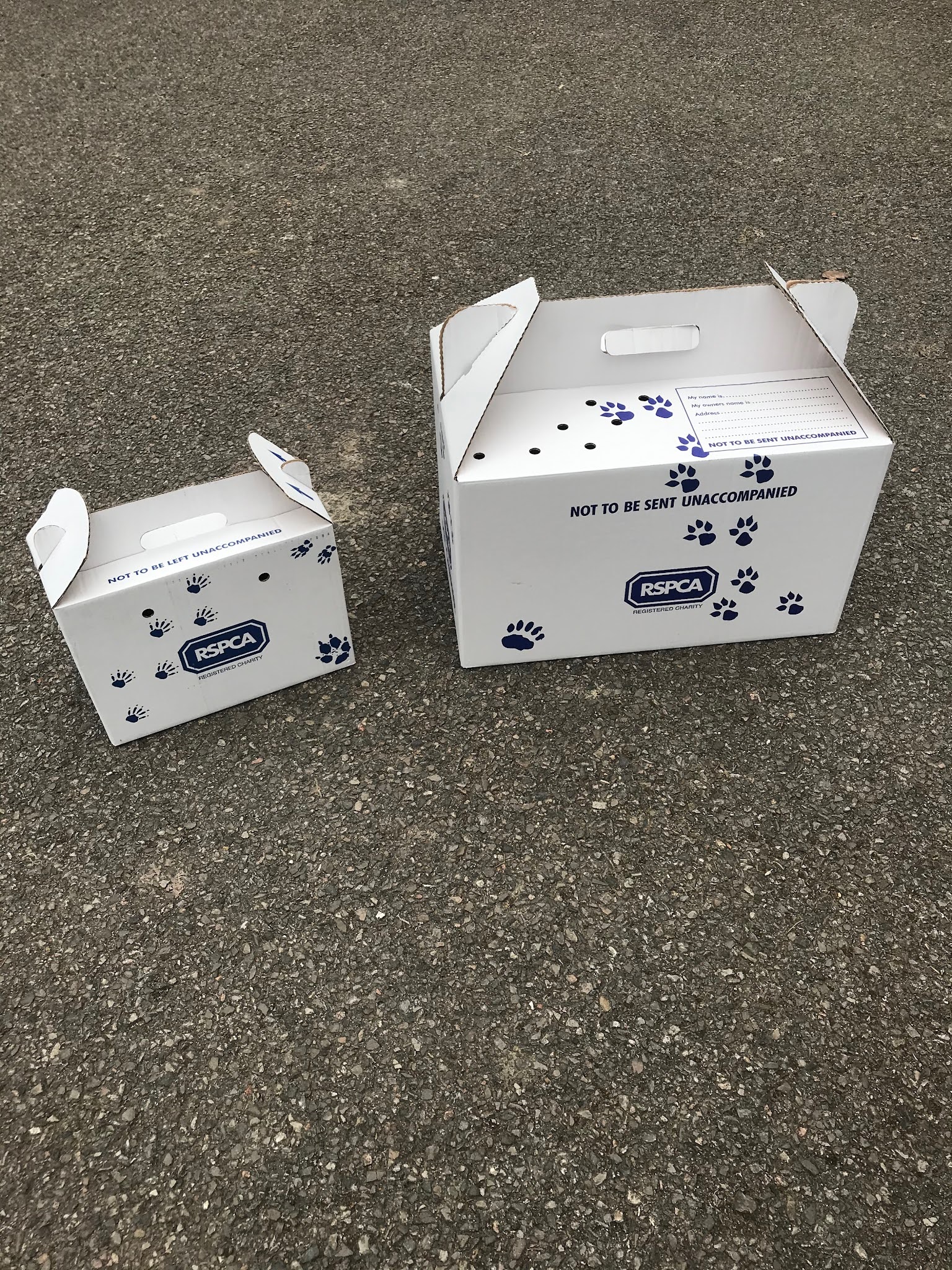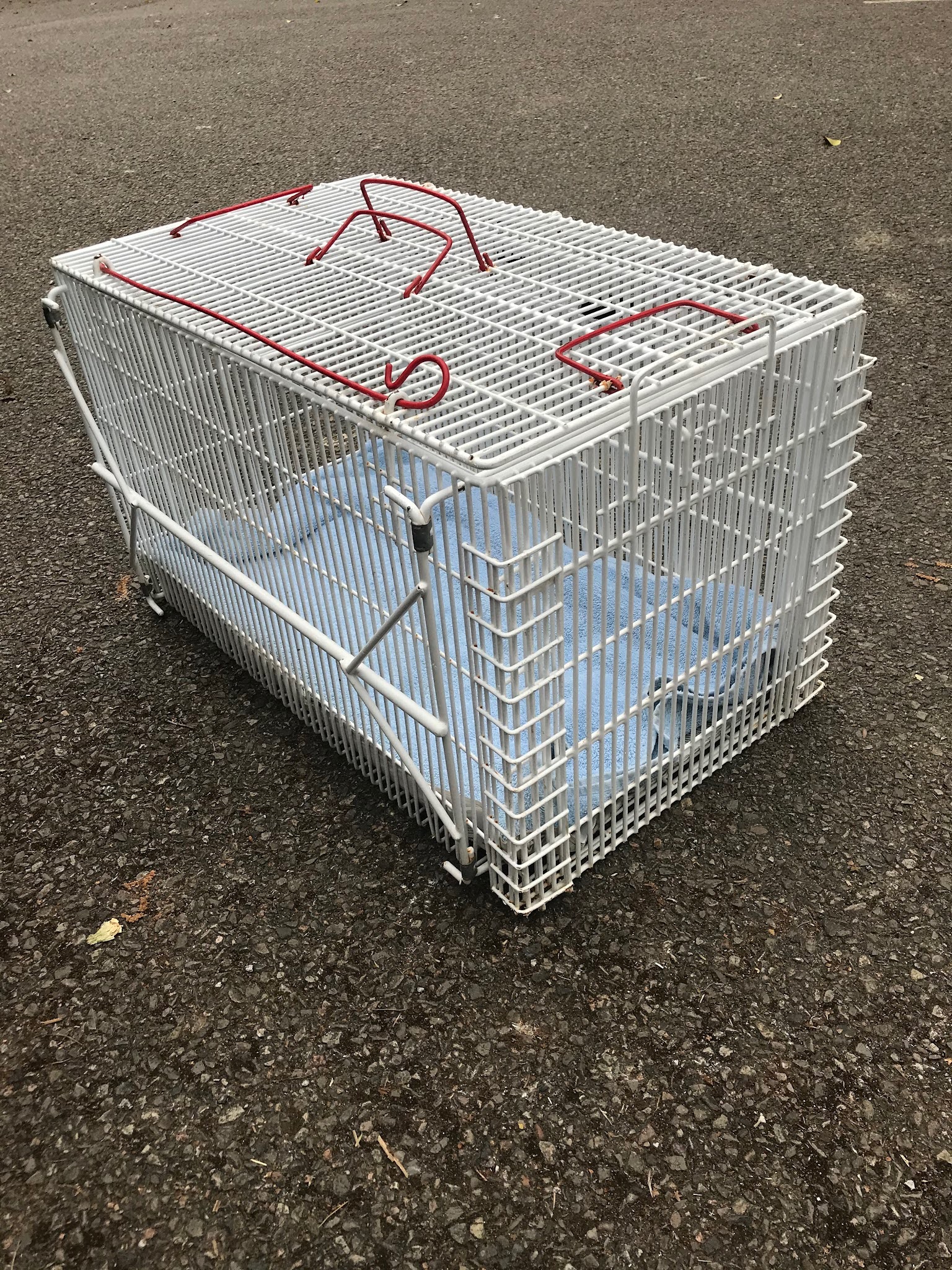Dealing with a wildlife casualty
Rescue, assessment and prognosis for trapped or entangled wildlife casualties.
Contents
What to consider
- What we are likely to ask fire service to attend with ourselves or on their own.
- Things to consider when assessing a trapped/caught animal and looking at possible injuries or complications that may arise.
- Does a casualty require to be euthanised in the field, reasons why we may consider euthanasia, but also those which can be released in situ or go through rehab due to a good prognosis.
- Usual H&S considerations (animal and environment) - not in depth as they risk assess already. PPE and equipment to take on the rescue.
What incidents you’re likely to come across
General situations we encounter on a daily basis in the field and which we may regularly ask F&R assistance for. They may also attend on their own, where we have no resource available.
- Birds that have been caught behind/under or entangled in netting (mainly gulls and pigeons, but sometimes corvids or birds of prey)
- Deer, Foxes or Badgers caught in fencing (wire/barbed wire or electric fencing tape) or sports netting
- Badgers and Foxes caught in snares. Snares are rare, but come with important considerations - never release in situ, must always be assessed by a vet or wildlife centre.
Birds in netting
What do we consider when assessing a bird in netting.
Do we know how long the animal has been trapped?
It might be only an hour or so, but it may have been overnight or potentially a few days. Is the bird therefore tired or weak from struggling to get out or possibly dehydrated and has it sustained any injuries?
Was any of the netting caught tightly around any limbs (legs or wings)?
Even if no obvious marks from netting eg. bruising or open wounds, it’s possible for damage to develop potentially a week or up to two weeks later on from being trapped - PRESSURE NECROSIS.
Injuries - may be just superficial injuries, slight scuffing to skin or no visible injuries at all. But may be broken skin or bruising - bird should come into care.
Pressure necrosis - possible you can get this at the injury site, may not show until a few days or even a week or more after the animal has been in care - damage of the soft tissues by prolonged pressure from the netting (a constriction injury). Can lead to swelling, blisters, fluid retention, skin discolouration and can be painful. Blood supply to lower limb area may also have been compromised. Affected sites need monitoring. Tissue can get infected also, so may require cleaning or ABs.
Vet attention, rehab or euthanase?
- Birds that have had netting tightly wrapped around legs and wings, especially the wing joints - think PRESSURE NECROSIS.
- Extensive soft tissue injury - poor prognosis, infection likely - euthanase.
- Birds with any broken bones or compound fractures - euthanase (exception mid shaft closed fractures - vet assessment required).
- Missing limbs - possible the leg/foot/wing or part of the leg/foot/wing has become detached - euthanase.
- Feather damage or feather loss, especially to flight feathers and tail feathers - needs assessing.
Why do we make the decisions we do once that animal has been rescued?
- Tightly wrapped netting - esp wing joints - may have obv bruising or wounds from the netting rubbing and from pulling, but also may not have obvious injuries, but potentially may still need assessing - think pressure necrosis.
- Euthanase - extensive soft tissue damage.
- Euthanase - broken bones inc. compound fractures, bone now exposed, high risk of infection.
- Closed mid shaft breaks can potentially be splinted or strapped but would need vet assessment as several things need to be considered.
- Feather damage - needs assessing by an expert in wildlife centre - can sometimes steam feather structure back into place, but there may be many missing flight feathers and is possible bird may require to euthanased.
Examples of birds trapped
Typical situations for us and for which we request fire service assistance - birds in netting on side of or on roof of building.
Things to think about - how is the bird caught, has it affected legs and wings or been caught tight around the body, is the bird tired or weak from struggling - does it need to come in to be assessed for a few days?
When asking F & R for assistance give the person going up the ladder cable ties so that they can close up any holes they may need to make. Not always possible depending on situation, but can help prevent other birds gaining access in.
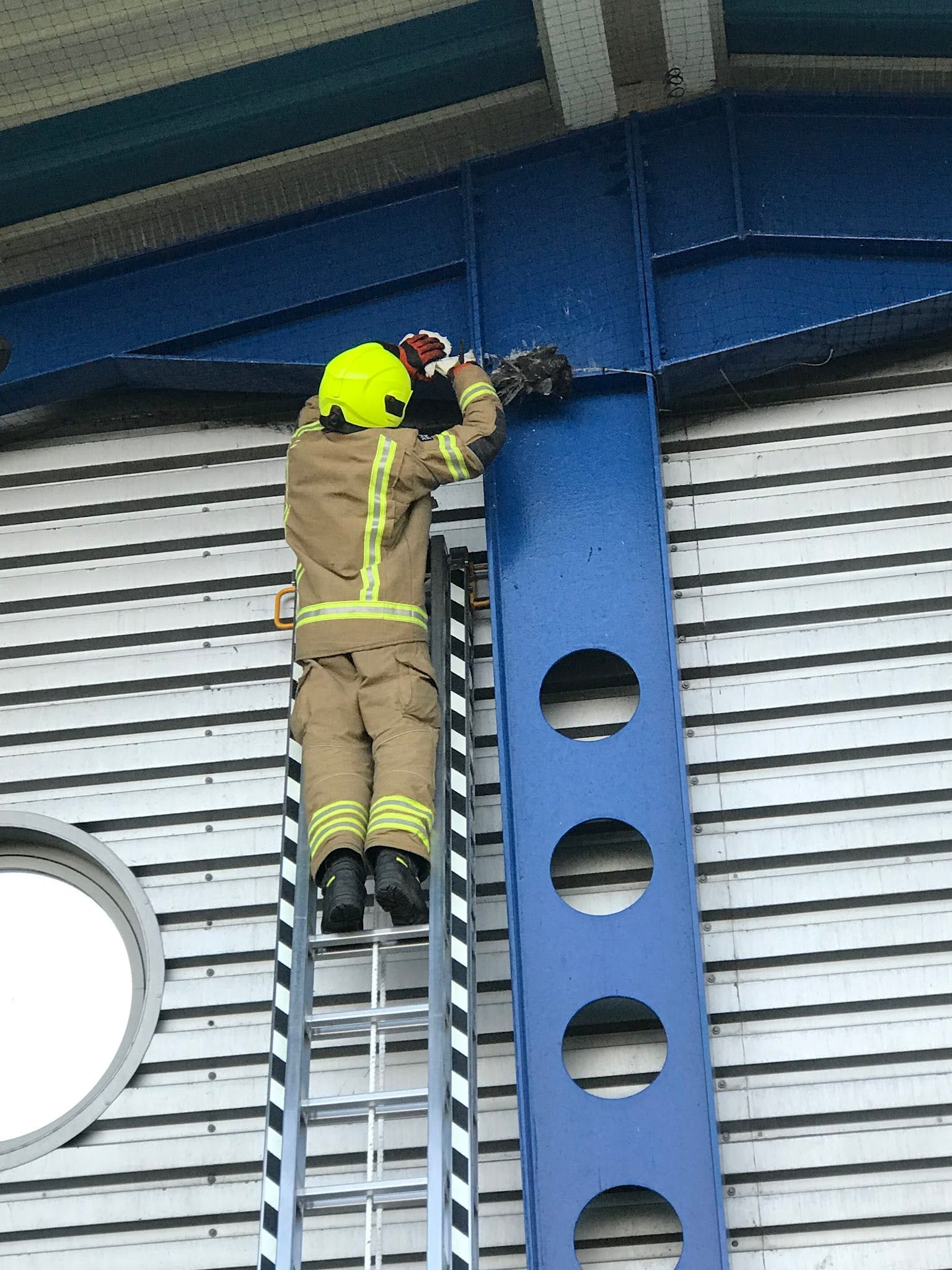
Second example
Adult Herring gull rescue - trickier rescue - required use of the ALP. Difficult access, narrow street and difficulty reversing ALP into position due to parked cars on the street. Bird successfully rescued. Taken into care as tired and needed full assessment due to netting caught tightly around lots of its body and high up on the leg areas and around wings. No timescale as to how long caught, was very high up so potentially not noticed for a period of time. Would need monitoring in care over a period of possibly a week or more to ensure no possibility of after effects (inc pressure necrosis).
More gull calls spring/summer when adult gulls are nesting on roof tops - sometimes chicks also fall through holes in netting and end up underneath moving about freely but stuck.
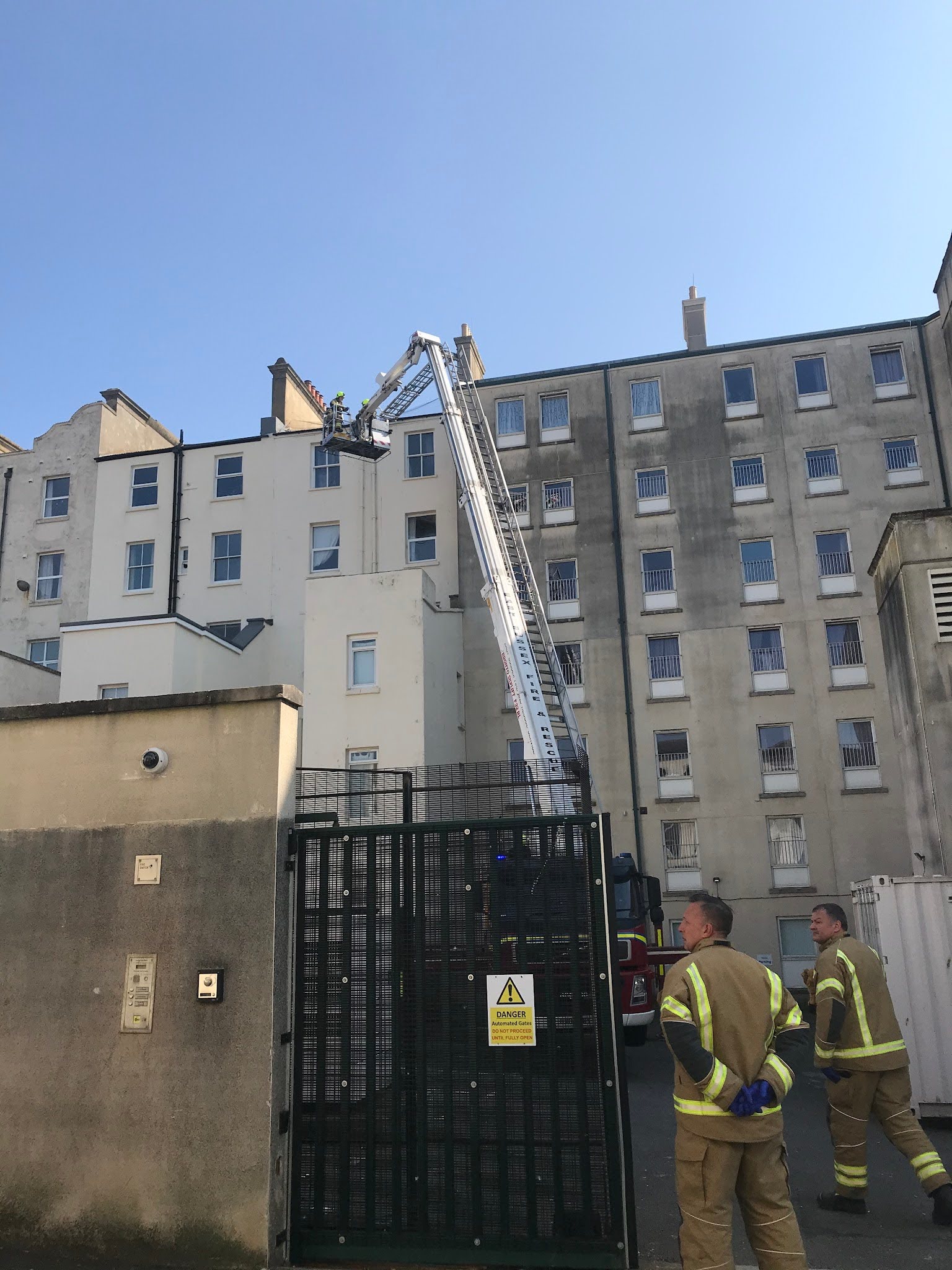
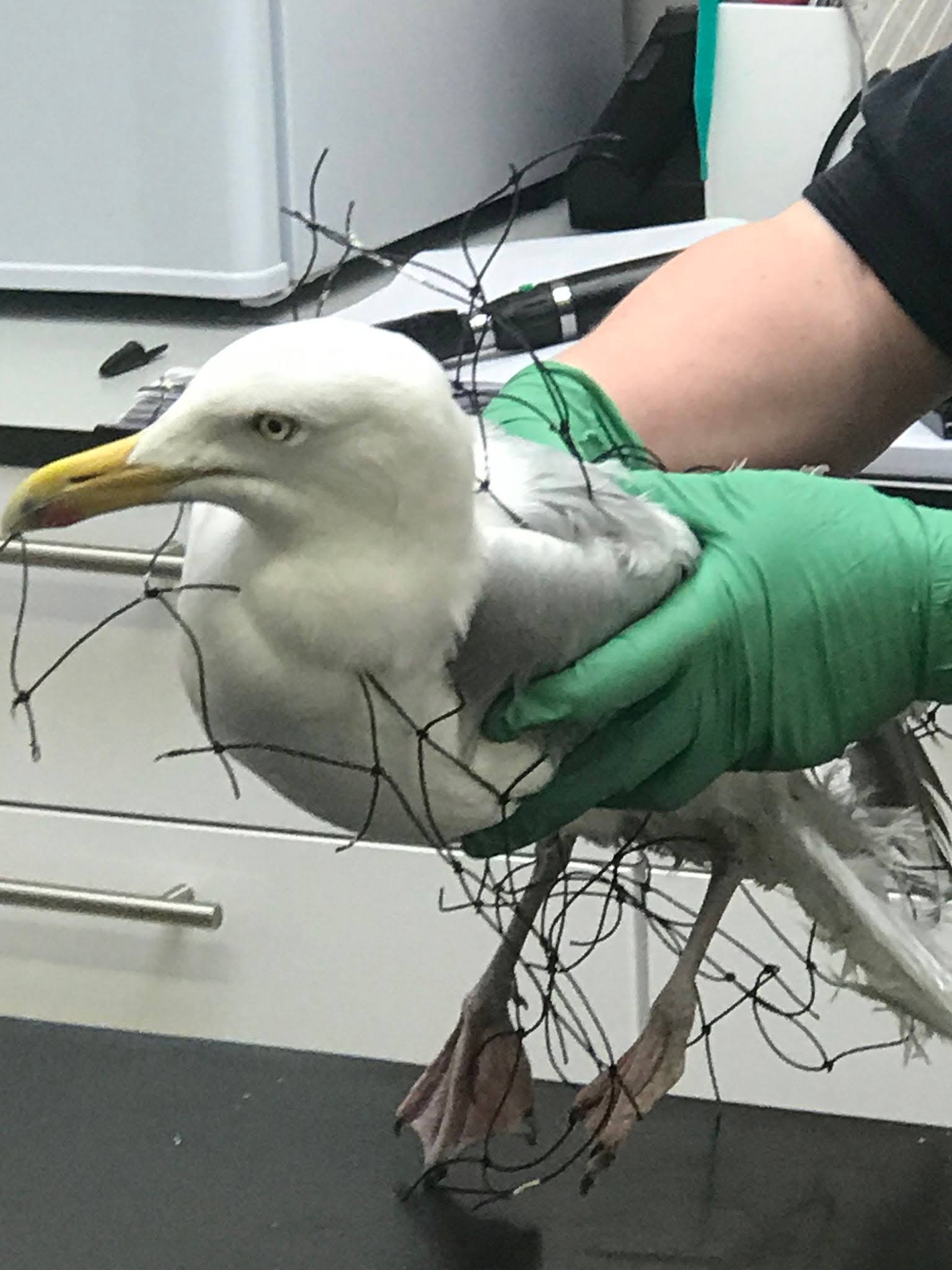
Birds injured by netting
Feral pigeon - caught by leg in bird netting on building - obvious digging in of the netting down to bone - candidate for euthanasia.
Adult Wood pigeon - was hanging by its tail, would have suffered damage to tail feathers which could have been steamed back into place - however died following rescue as was being assessed for injuries - some birds are more susceptible to stress than others, is possible birds will die during or after a rescue. Wood pigeons get highly stressed, may drop feathers also. Place quietly into a box if starts open mouth breathing and reassess after a period of rest/quiet.

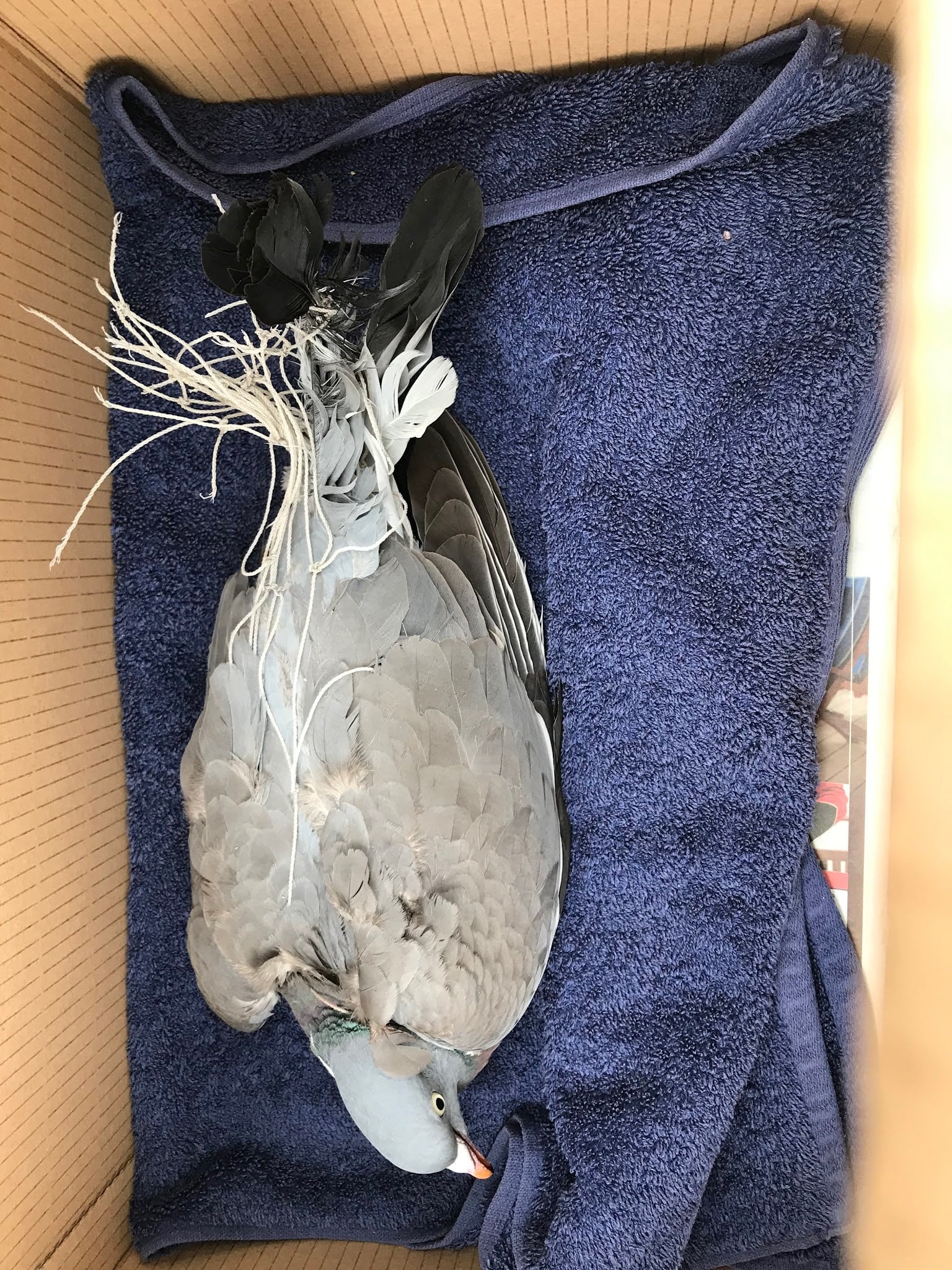
Birds hanging by fishing line or on TV aerial
These casualties MUST come into care - they are usually hanging by legs or wings for prolonged periods and will have sustained damage. They are more likely from the hanging nature to develop pressure necrosis later on or have issues from restricted blood supply to lower limb area.
Adult Herring gull hanging by fishing line from its wing, which it then got snagged on the side of a building - successfully rescued by fire service, but died once on the ground - very hot day, stress and exhaustion possibly the cause, unknown how long hanging for.
Middle pic - Adult Barn owl - caught in fishing line and hook and tackle.
Adult Herring gull hanging from a tv aerial in Eastbourne - successfully reached with the ALP - some damage to soft tissue of wing where spikes had penetrated through the skin of the wing (but not damaged muscle etc) and also some feather damage/disheveled flight feathers which were steamed back into place, but luckily no long term damage, released after a few weeks in care.
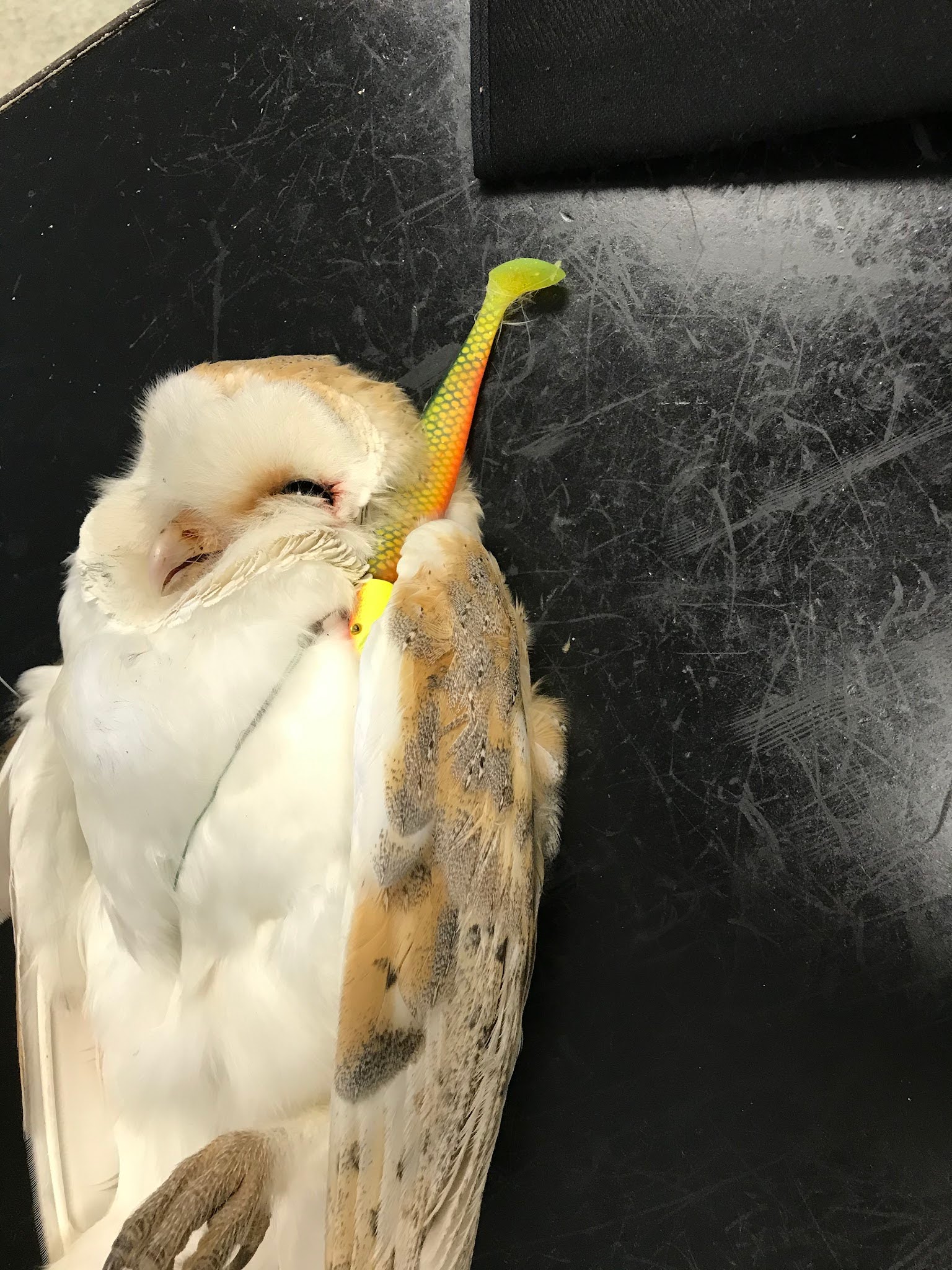
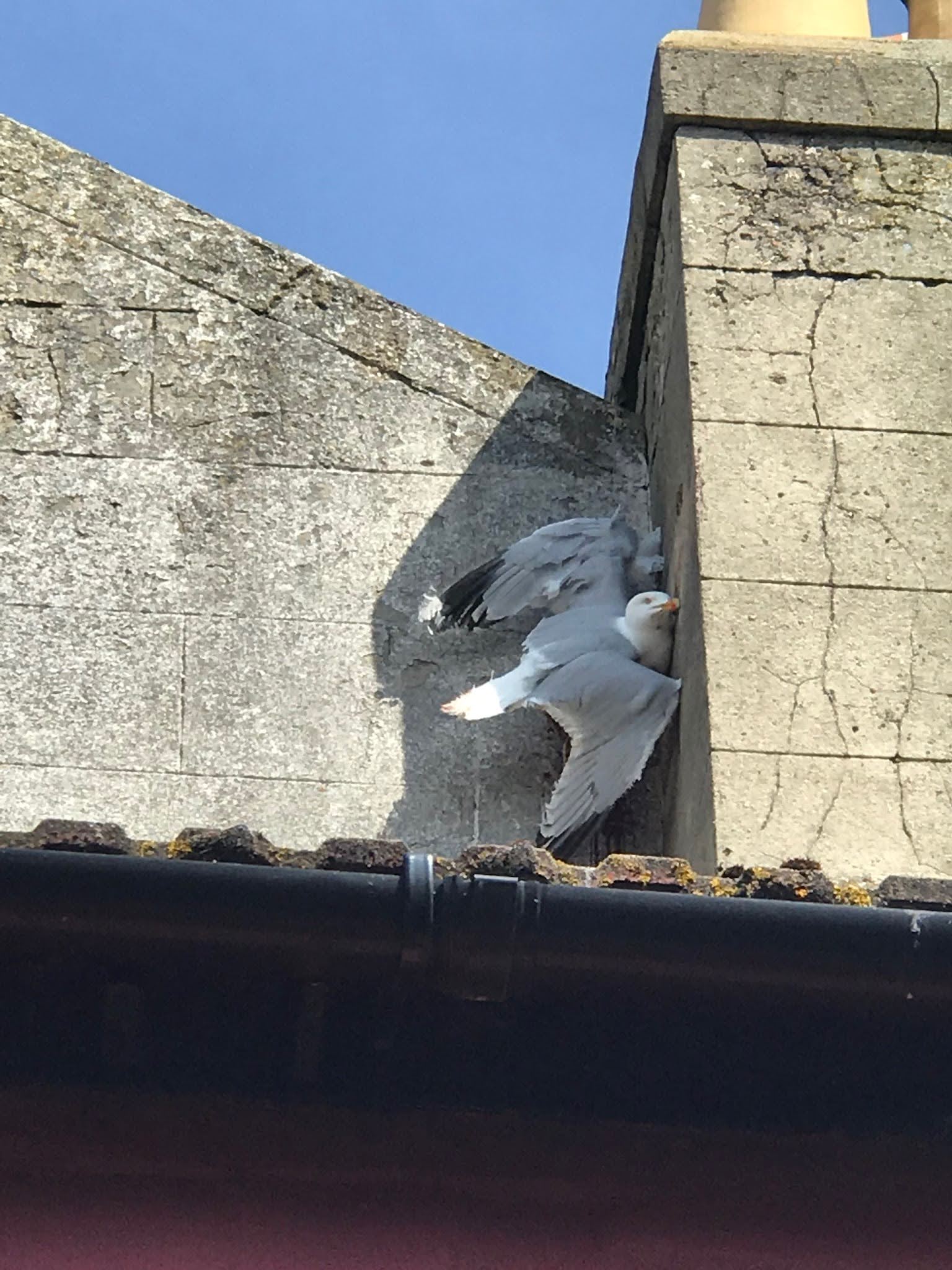
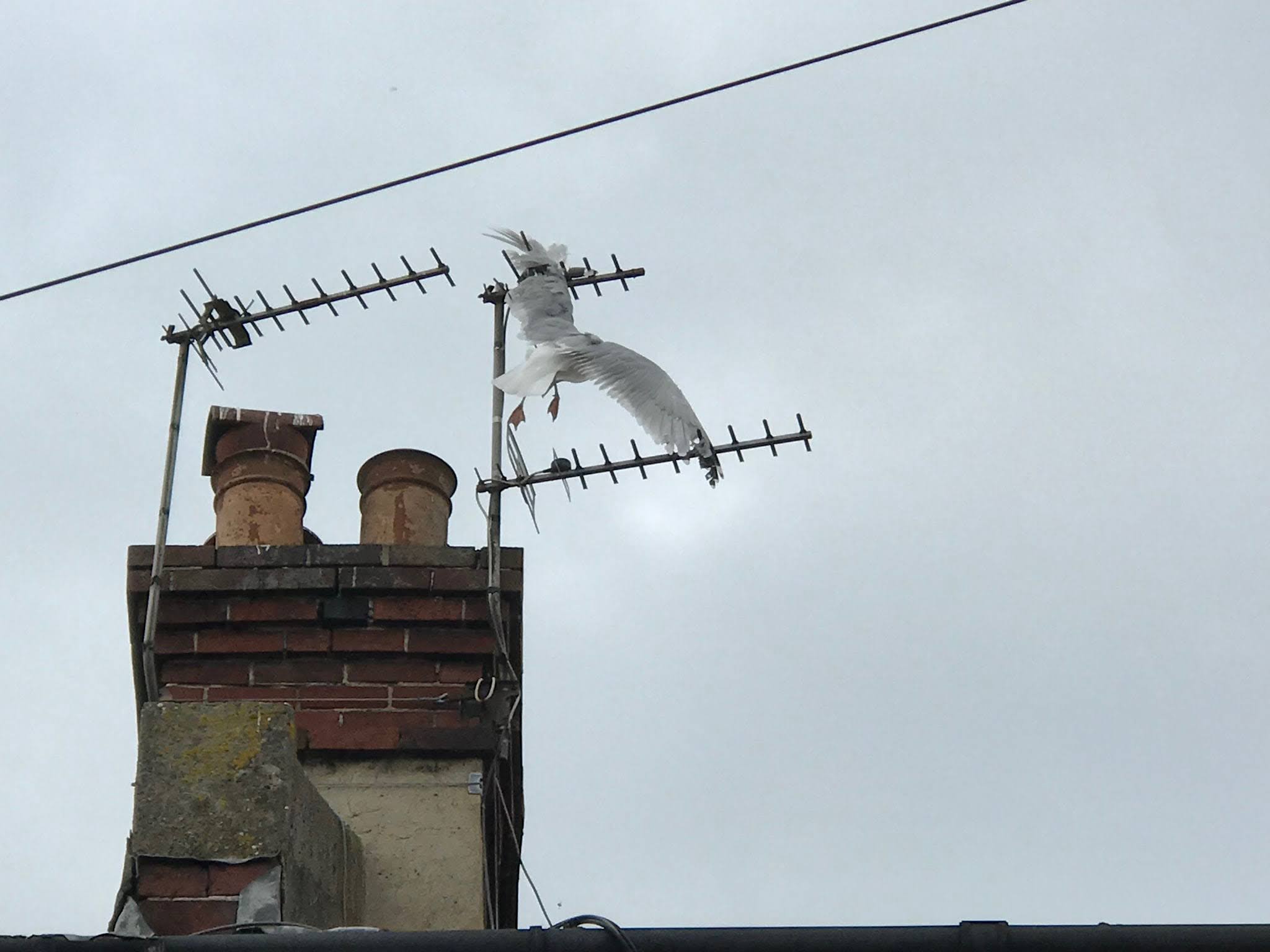
Fishing line damage
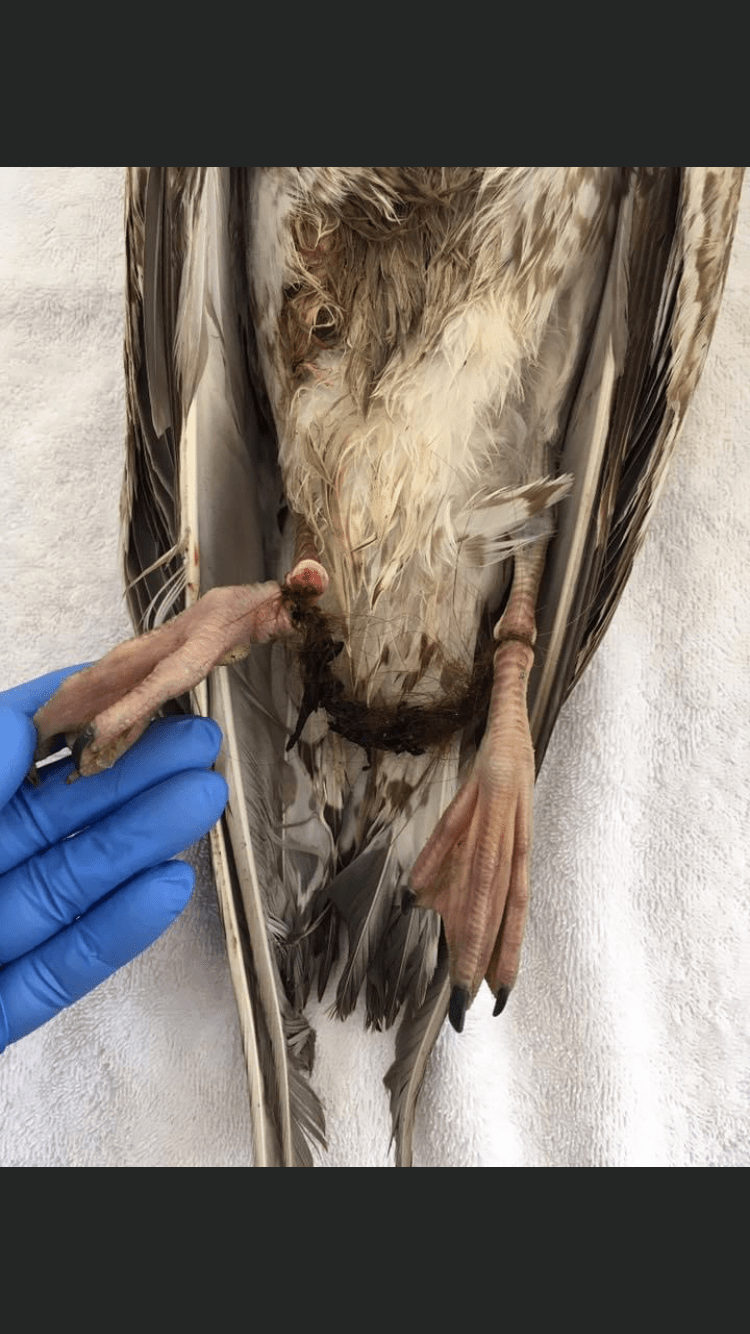
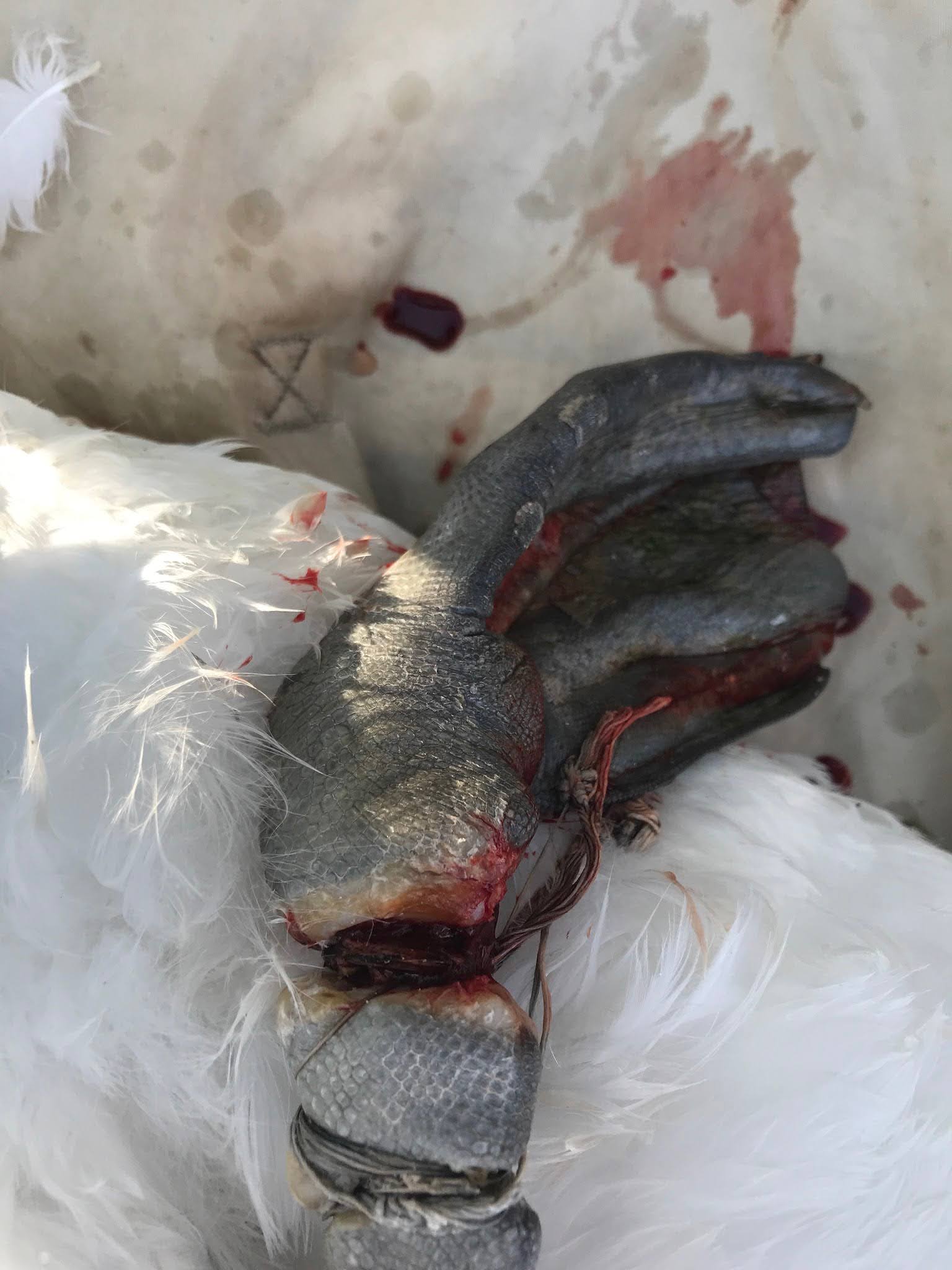
Deer
- What do we consider when assessing a deer in netting or fencing?
- Do we know how long the deer has been trapped?
- Is any of the netting or fencing caught tightly around any limbs? Think PRESSURE NECROSIS. Any obvious injuries?
- CAPTURE MYOPATHY - the body’s reaction to abnormal states - leading to severe muscle damage. Aim to minimise struggling and handling time and release ASAP.
- What species of deer is it? Is the deer an IAS (Invasive Animal Species)?
Sometimes we have no idea how long a deer has been caught for - dog walker might have spotted, usually alerted by their dog. It might be off a footpath, so potentially could have been trapped/caught for a day or even longer.
Any injuries to the deer? Think pressure necrosis - euthanase. Remember that these injured deer (unless fawns) will NOT be coming into care for rehab - highly stressed animals, being put into a highly stressed situation, prolonging suffering - we will be looking to put these deer to sleep.
Capture myopathy - triggered by stress. It is the body’s reaction to abnormal states eg. when a deer over exerts itself (eg struggling in a trap or fence), which leads to physiological imbalances, which result in severe muscle damage. Can occur only a few hours after release, or even several weeks after. Signs: Ataxia, muscle tremors, red brown urine, recumbency, loss of coordination, muscle paralysis, depression, increased temp, heart and resp rate. Hotter temps and chemical immobilisation increase the risk. Treatment is rarely successful and animal often dies from this condition. SO: we need to minimise struggling and handling time, cover head, release asap.
Touch on IAS (muntjac etc).
Situations we get called out to, as well as request fire service for assistance
Several things to consider when rescuing deer - size, antlers, stress, high risk incidents for all involved.

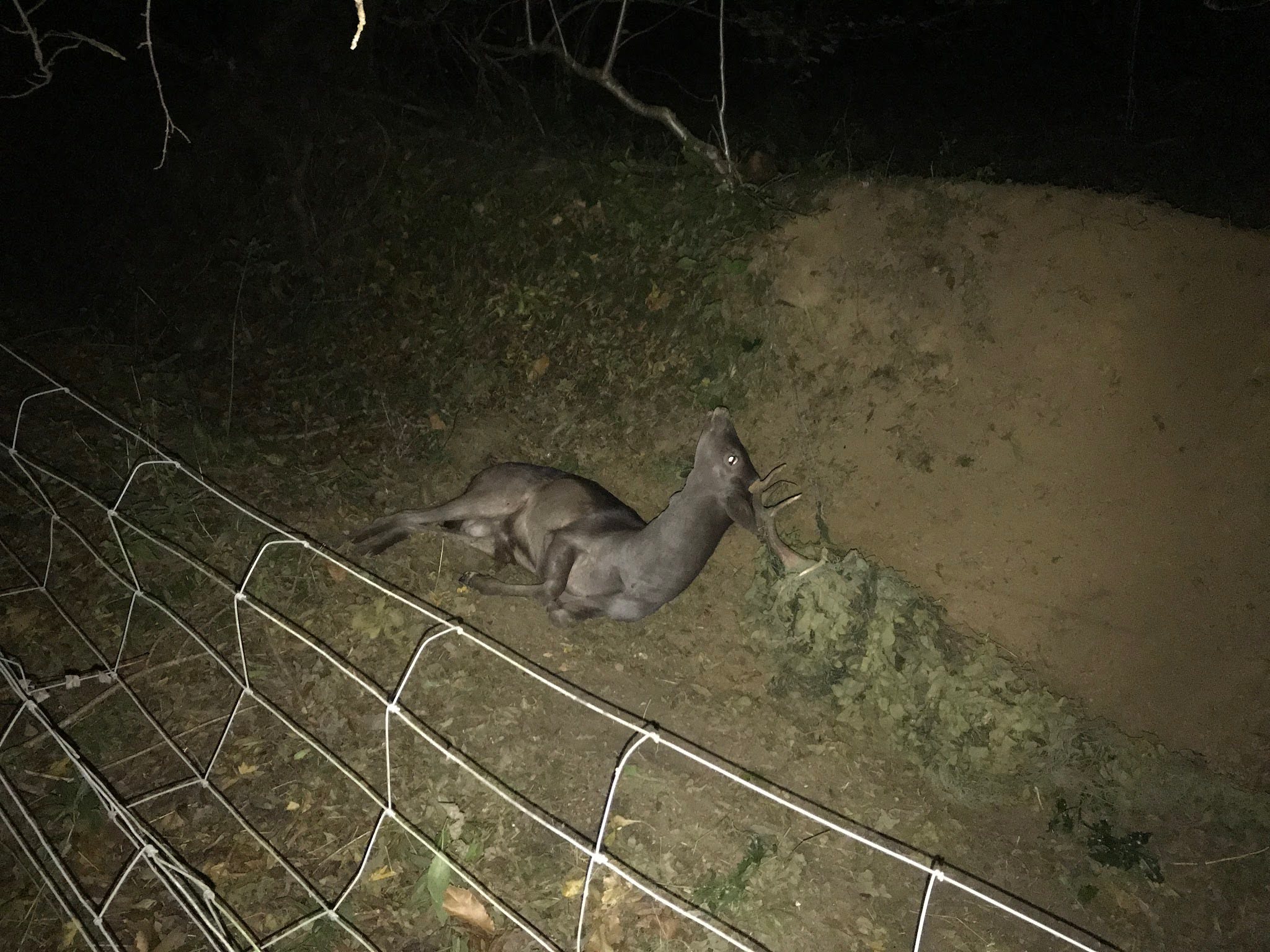
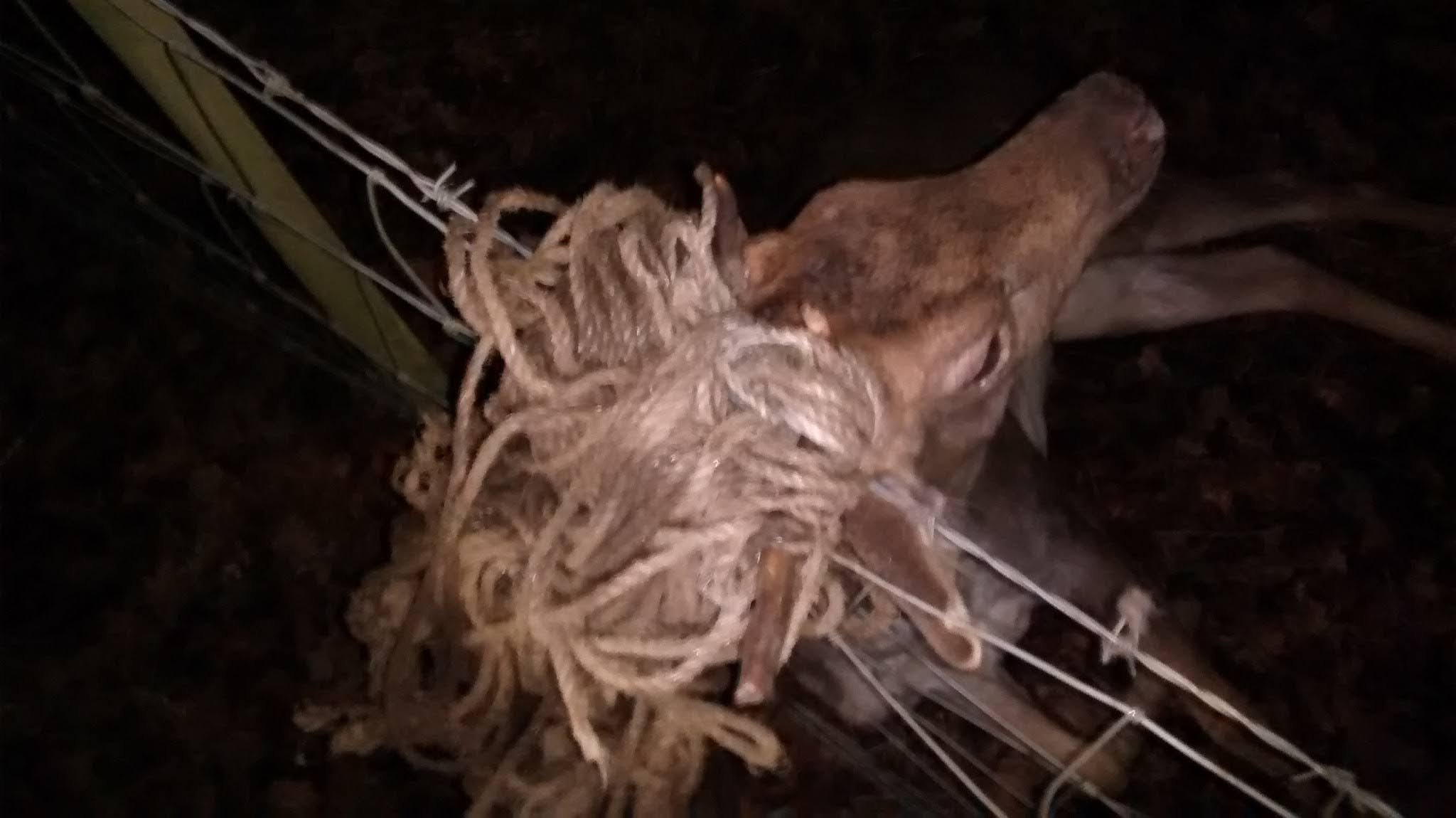

Deer caught in netting
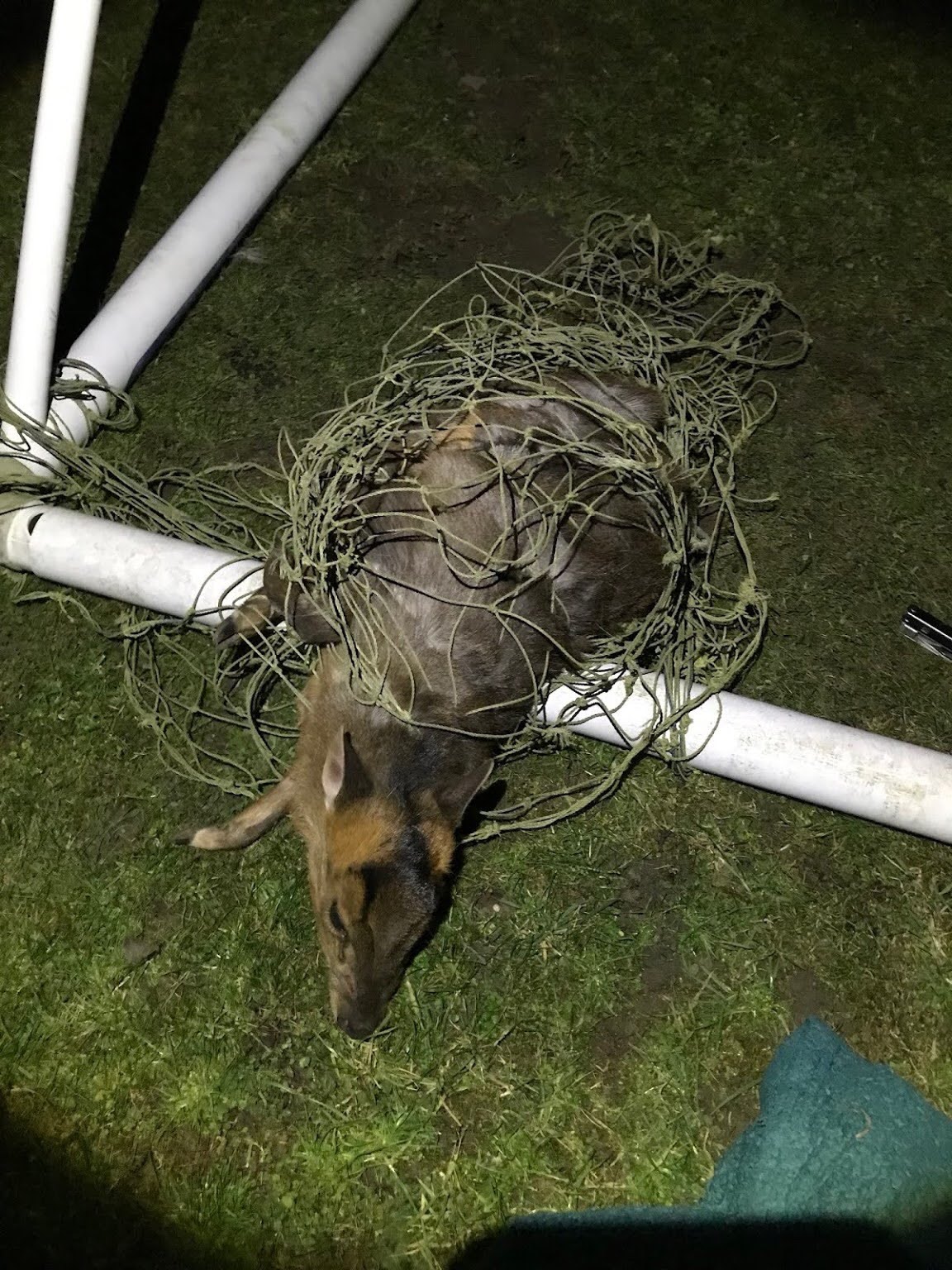
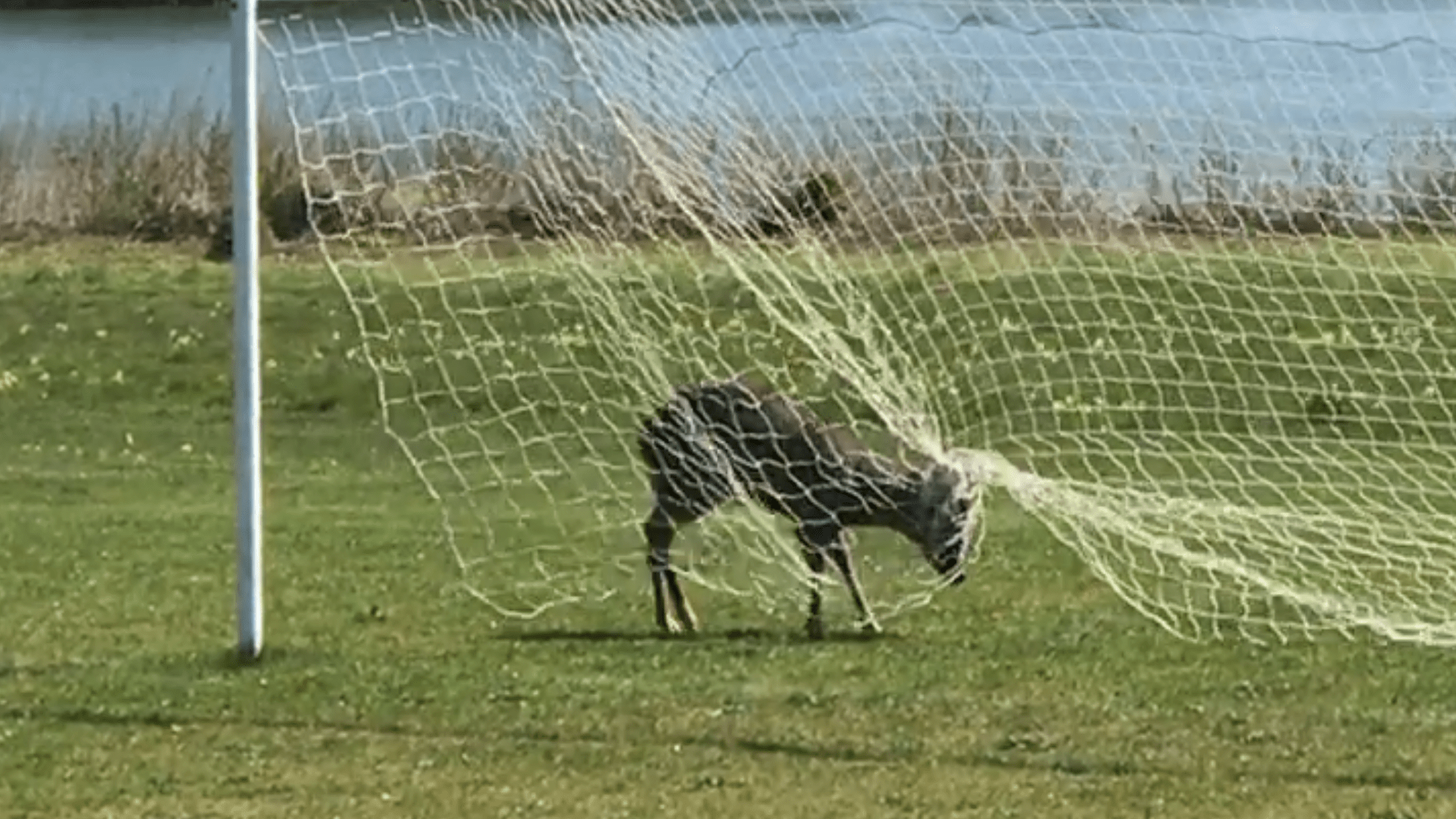
Deer caught on fencing
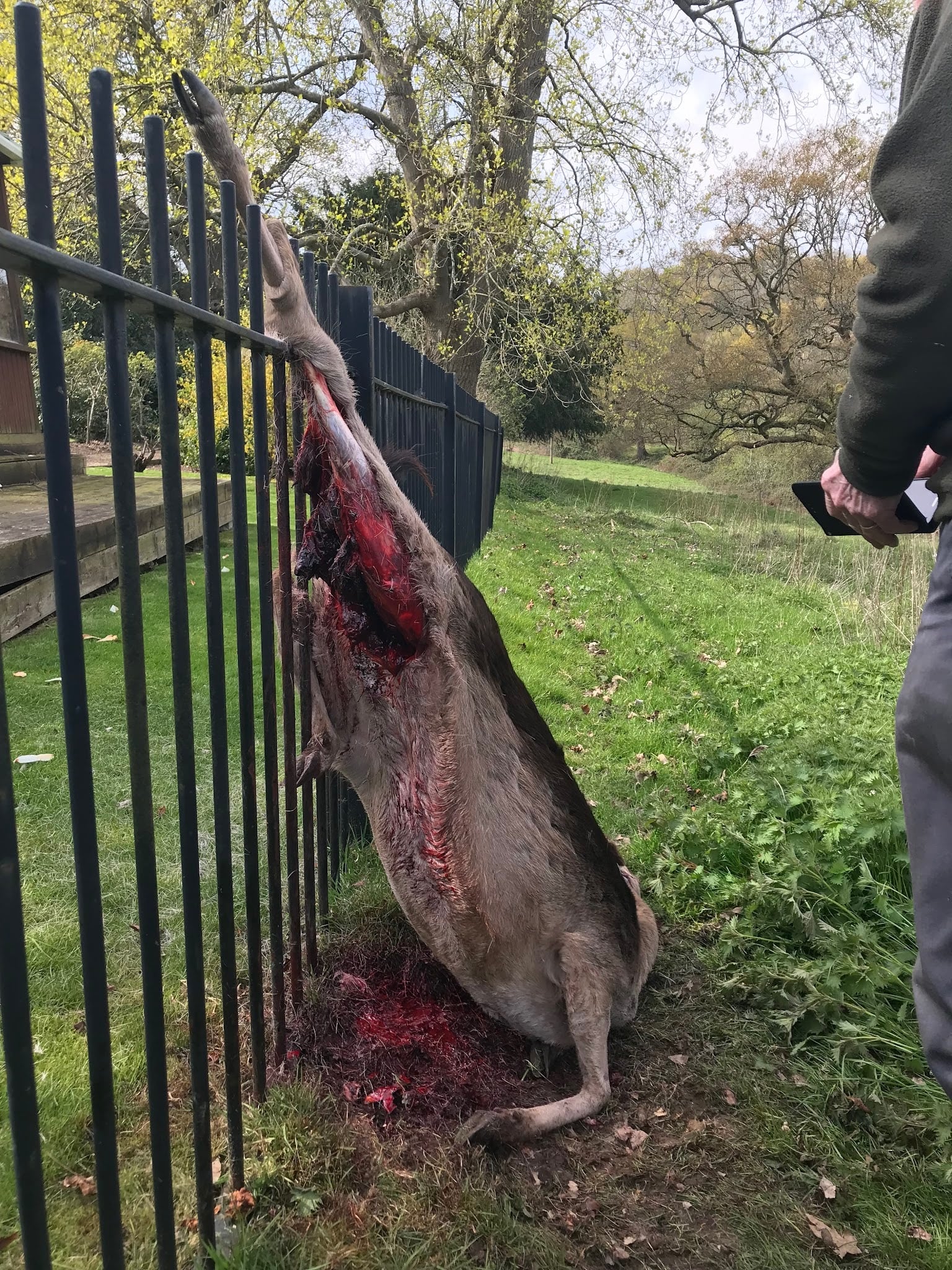
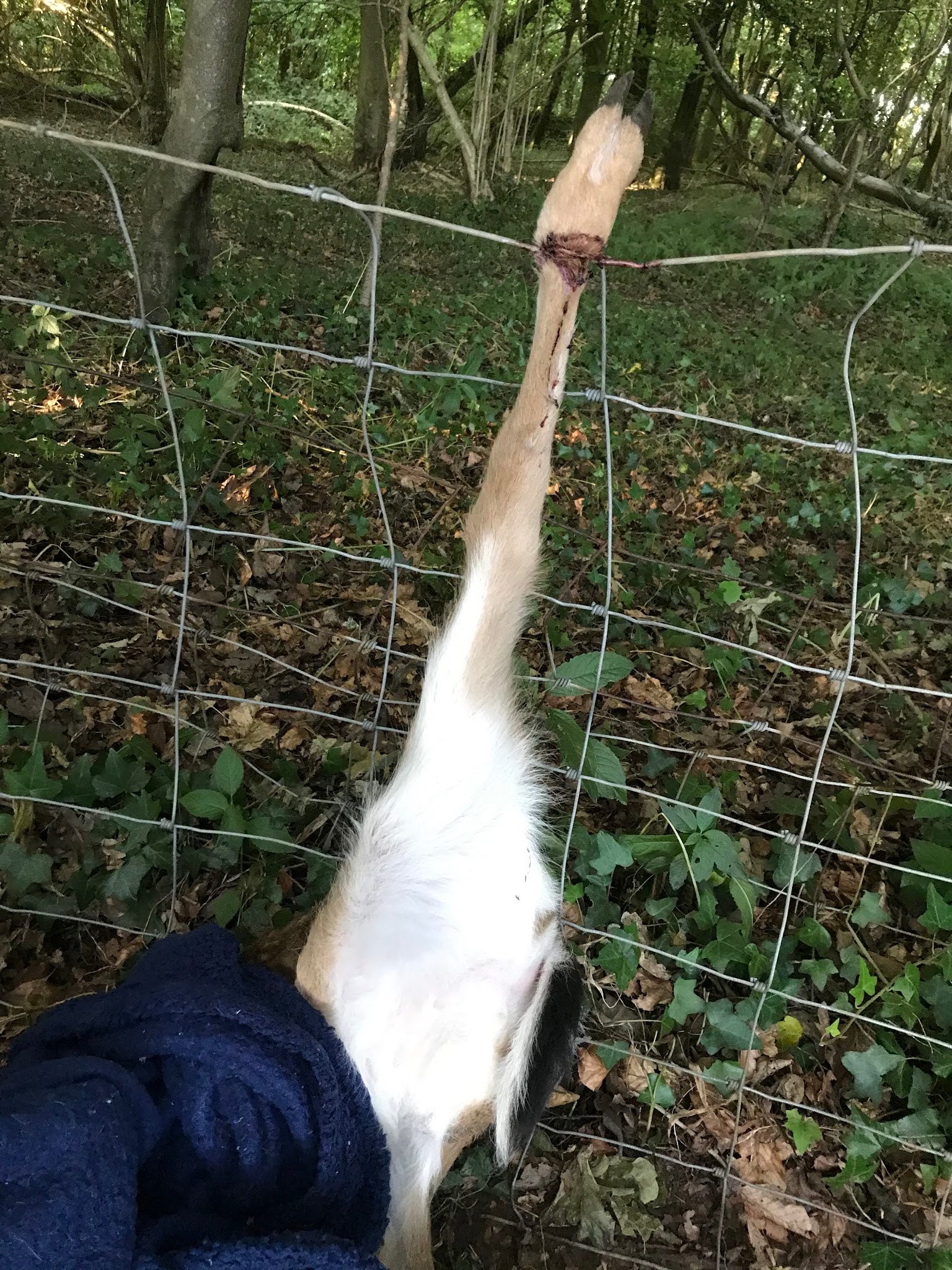
Deer caught between railings
Sometimes get called to deer or even foxes or badgers that have become stuck trying to squeeze through metal rail fencing - usually get stuck around the abdomen in front of the hind legs. Can be successfully removed (can use a car jack to lever open the railings to give the animal space to then release itself).
NB. it is possible they may have injury from continual pulling to get free prior to your arrival, can have sore areas on sides, or even open wounds, and can possibly have damaged their back end and have issues standing or walking on release. Can also have exhausted themselves. May require euthanase depending on injuries etc.
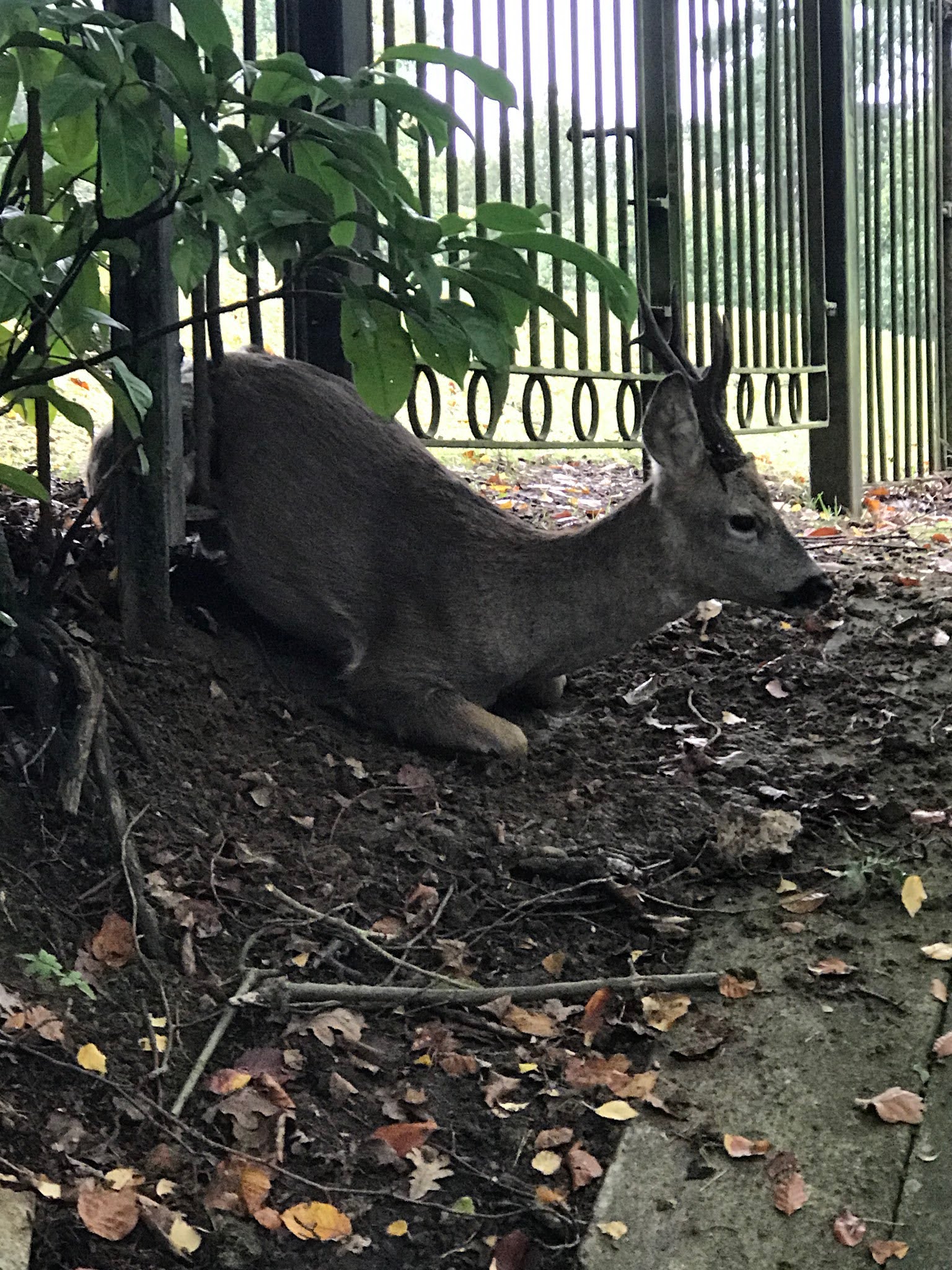
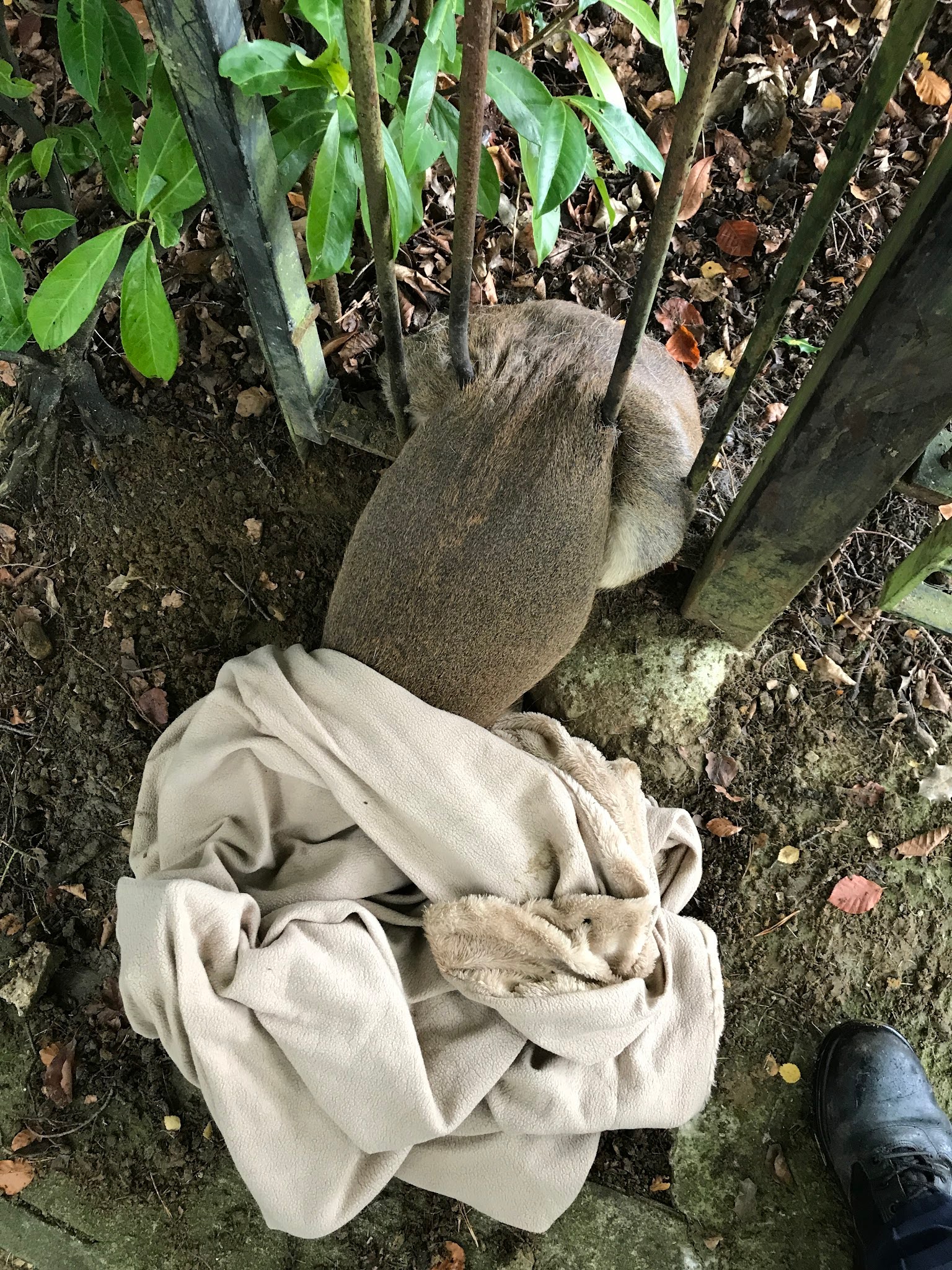
Foxes and badgers in netting or fencing
What do we consider when assessing a fox or badger in netting or fencing?
Several of the same considerations as with deer:
- Do we know how long the animal has been trapped?
- Is any of the netting or fencing caught tightly around any limbs? Think PRESSURE NECROSIS. Any obvious injuries?
Obviously easier to handle than deer and can be transported easily, so potential for assessment to be made at a vets or a wildlife centre.
Same considerations as with deer to some degree, but obv due to easier handling and being able to transport, can be assessed by a vet or at a wildlife centre if needed.
Foxes and badgers in netting
Typical situations we get called to, as with deer or birds. Think about injuries which may not arise until a few days after release - pressure necrosis.
Sometimes you man not be able to get all netting off things like badgers or foxes as they do become very entangled, so sometimes may need to get to a vets for help removing everything (sometimes requires gassing down or sedating)
Touch on handling, use of graspers, H & S to consider when handling. Badgers more difficult to handle etc.
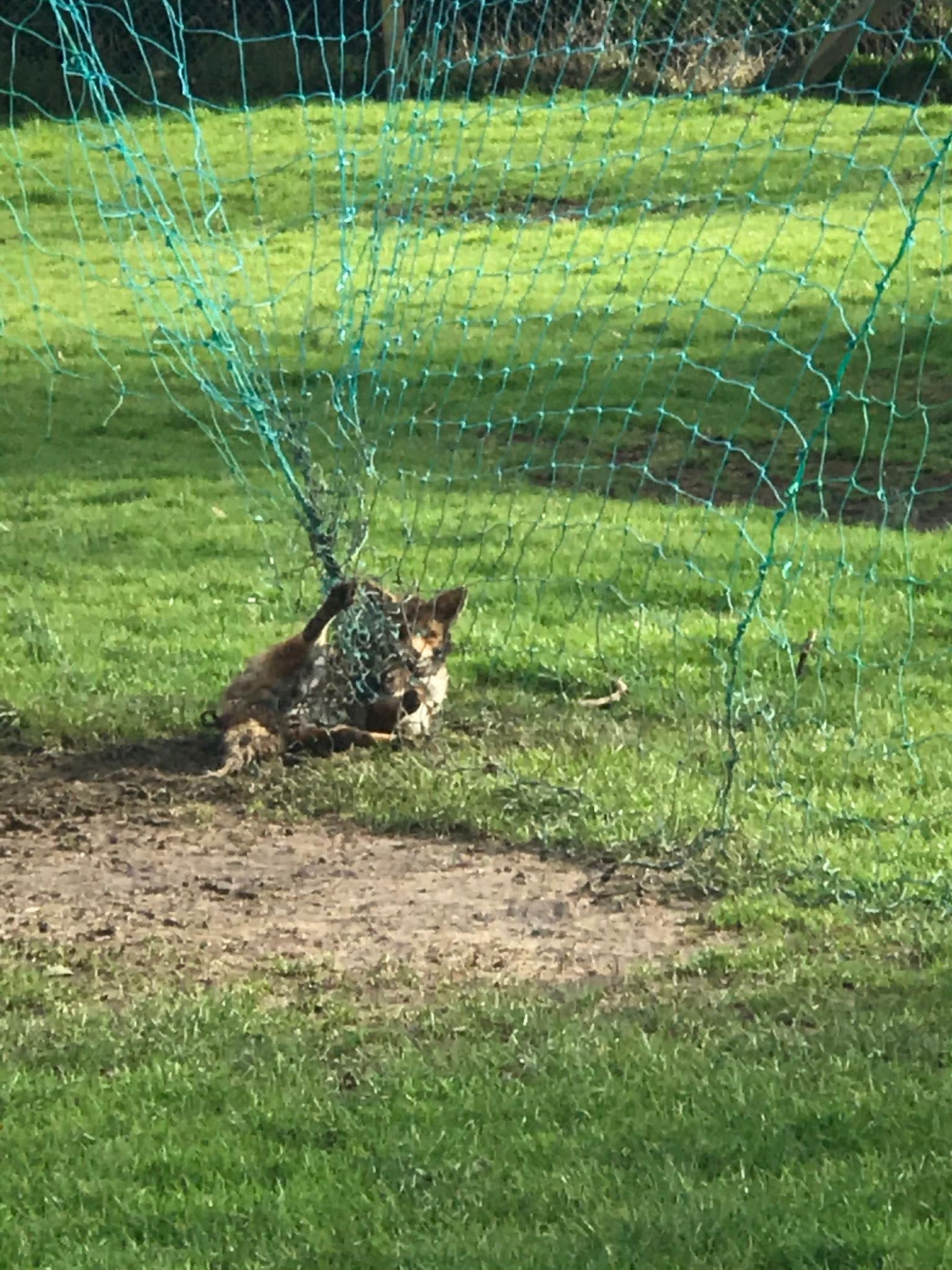
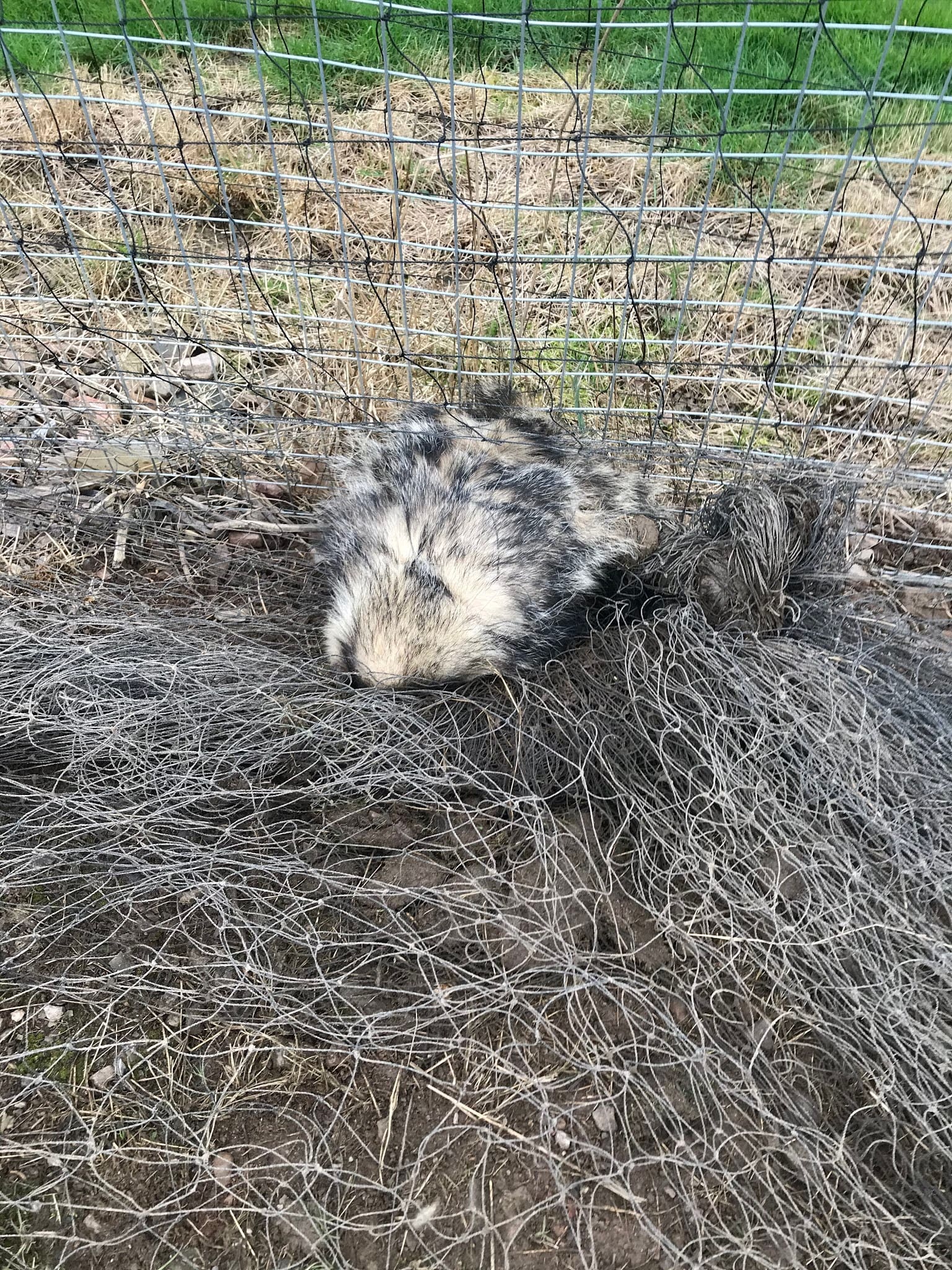
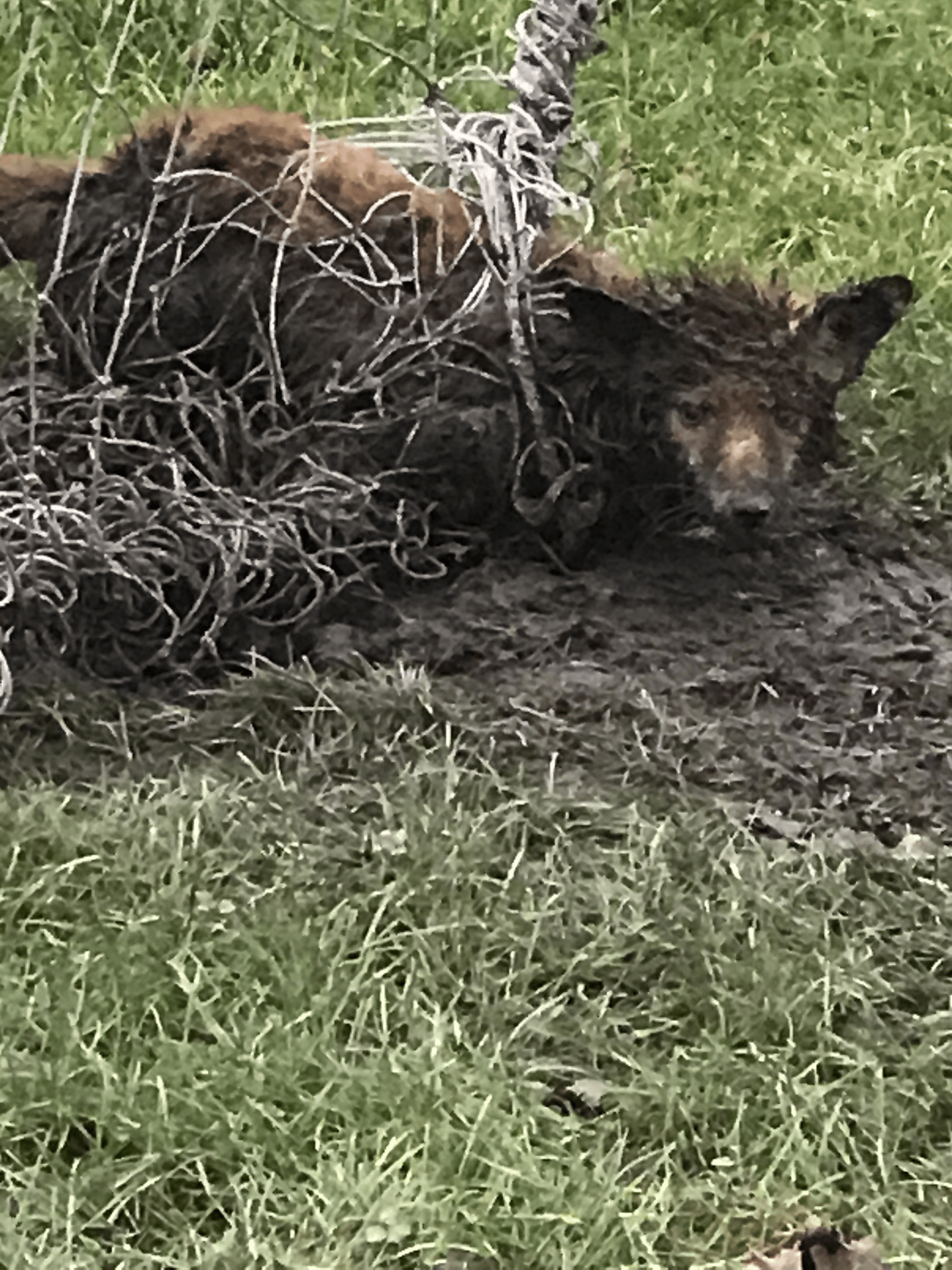
Foxes in fencing
Typical presentation of a fox in fencing for us - jumped over and get a hind leg caught up, now left hanging. Like we get with the deer.
Is very unlikely that there won’t be any injury or digging in of the wire - they will pull and pull and it will dig in.
Very unlikely this will be released in situ due to possible damage or potential for pressure necrosis to present itself down the line - will require vet assessment or possible euthanase if very bad or down to the bone.
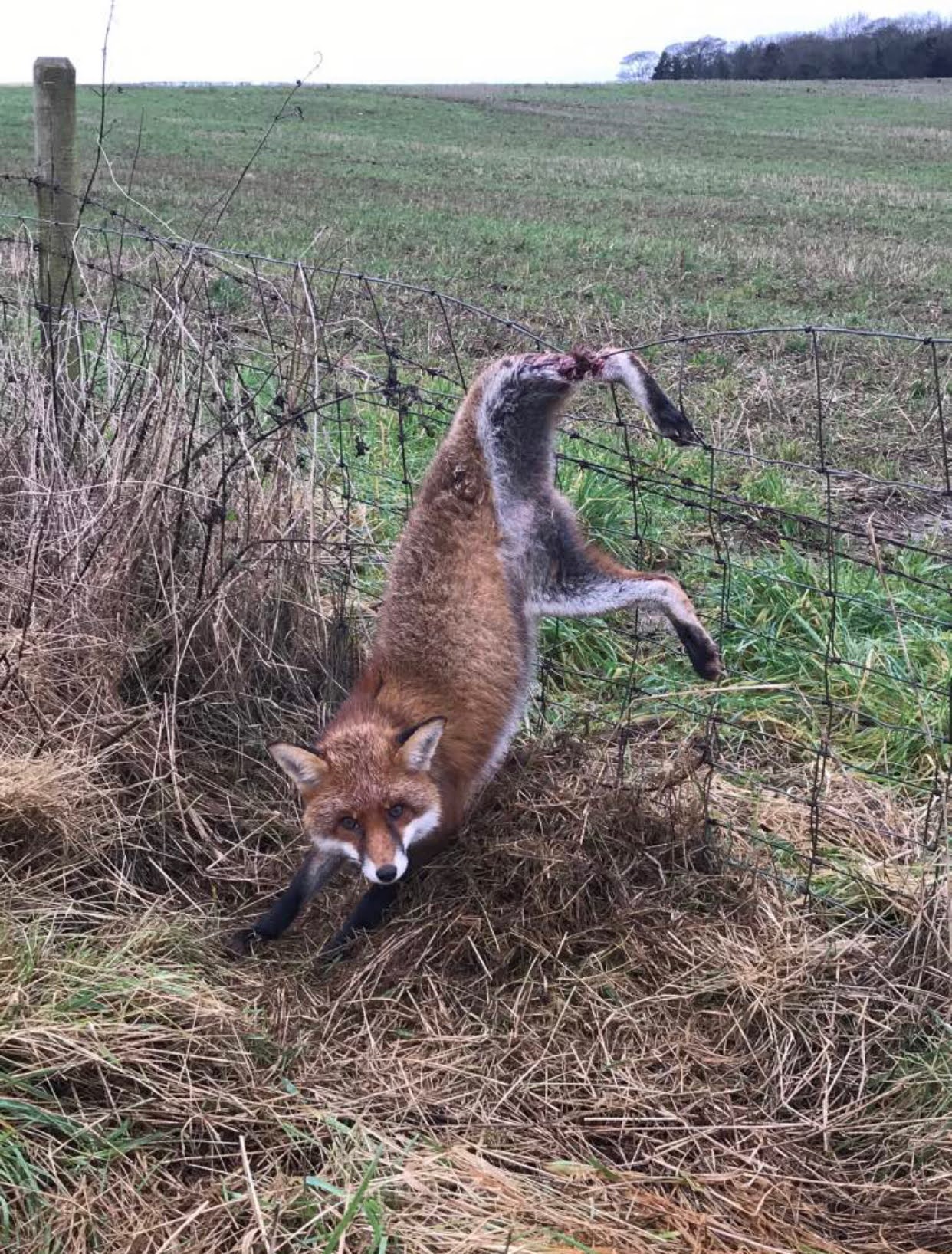
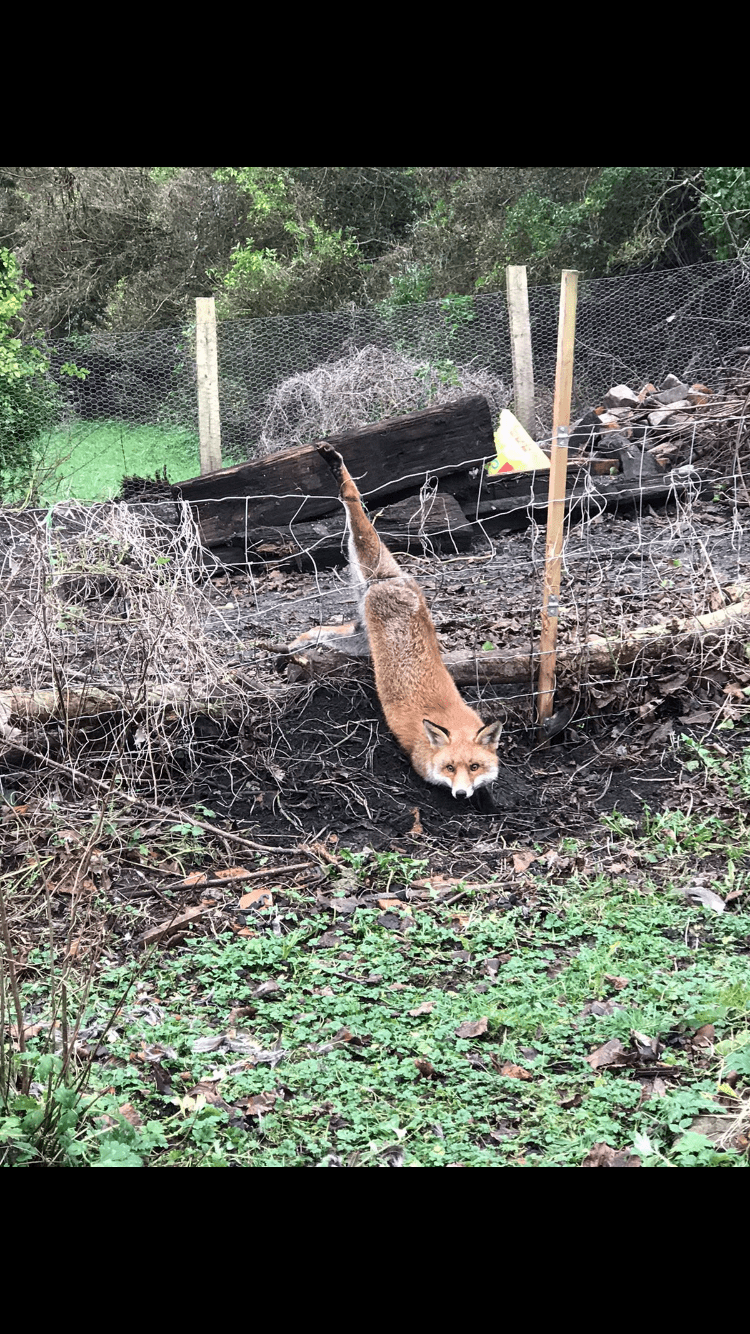
Snares
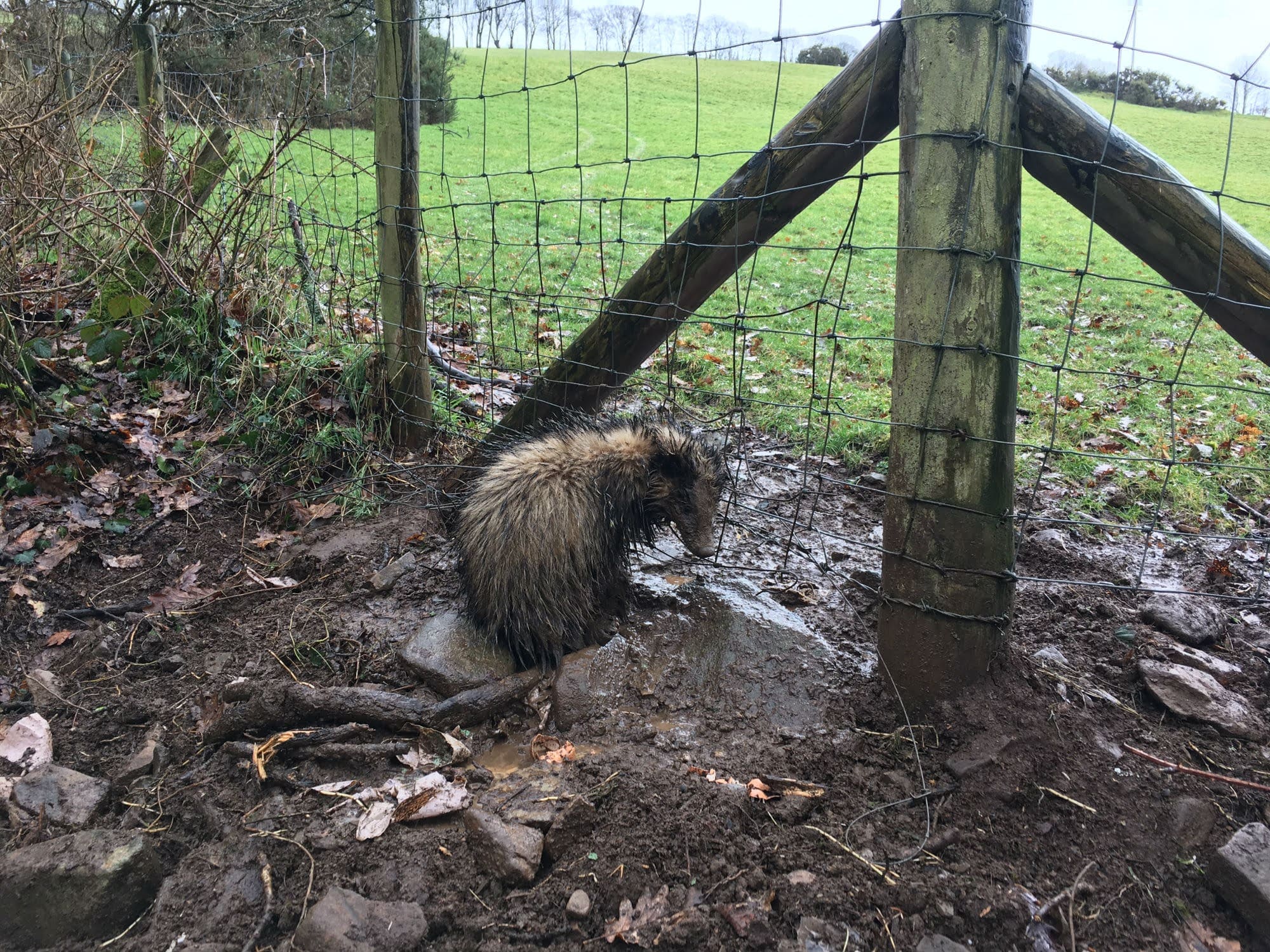
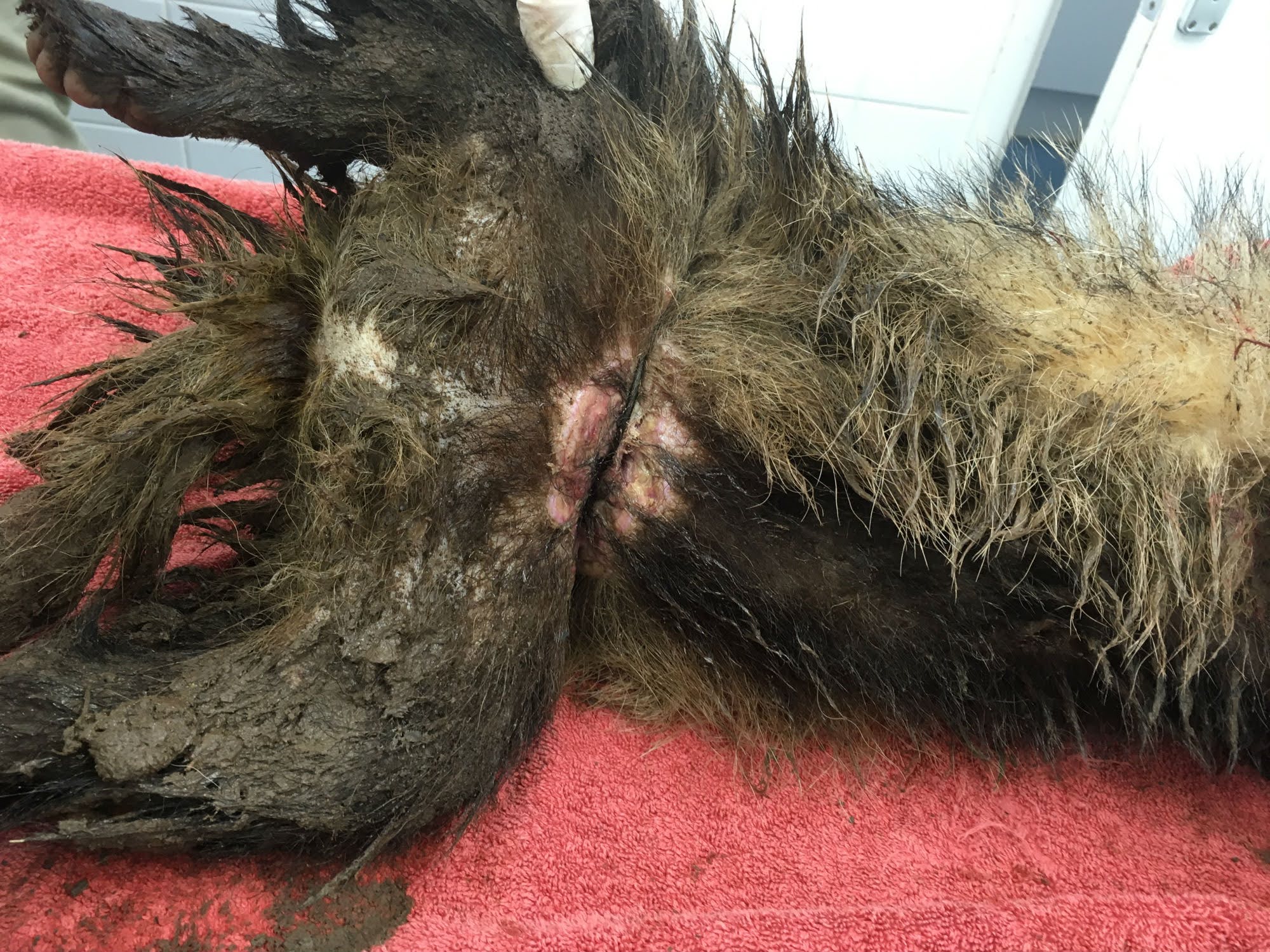
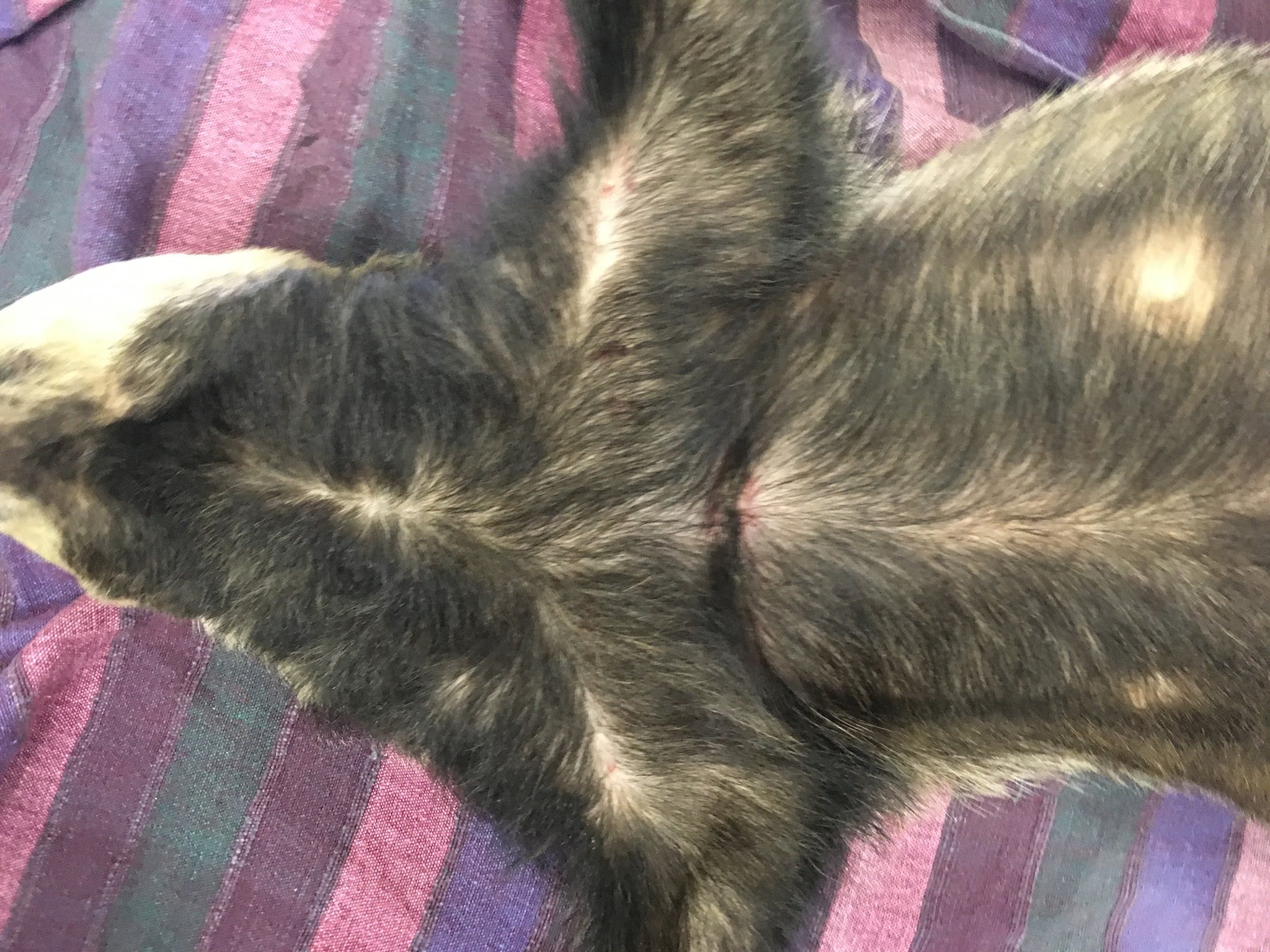
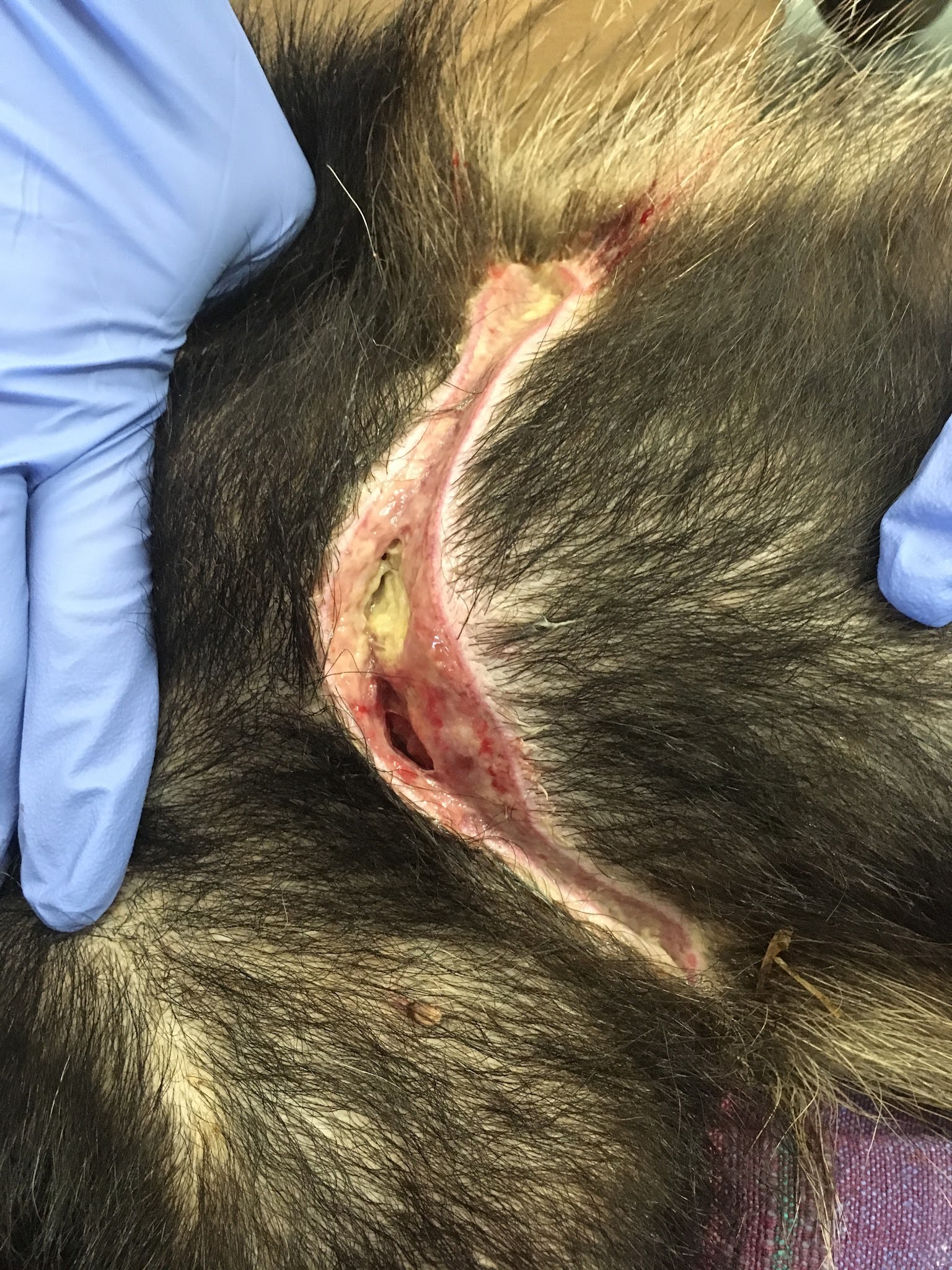
Health and safety
The animal:
- The animal will try to defend itself, it may kick, bite or scratch you, or if it is a deer with antlers, it can gore you.
- Even if trapped, they can potentially still lunge at you!
- The animal may also have disease - potential risk of zoonotic transmission eg. leptospirosis or mange from foxes.
- Manual handling
The environment:
- Weather, poor visibility, difficult substrate or terrain, near or in water, near or on a highway.
- Working at height
- Is the rescue being carried out during the day or at night, or when the light is fading?
Mainly highlight the risk from the animal to the handler, inc zoonotic side of things.
Remember
No incident or animal is more important than your own safety and security. If you have to delay the rescue or collection because it is not safe or you do not feel safe, then do so.
If you are unable to carry out a rescue without our assistance, then please request it and delay the rescue if necessary, especially where daylight is an issue. Some rescues may need delaying until the morning and a plan put in place.
PPE and equipment
- Towel/blanket - to cover the head of the animal to calm it
- Disposable gloves
- High vis jacket
- Hard hat
- Protective eyewear
- Waterproof clothing/warm clothing
- Grasper
- Gauntlets
- Wire cutters/bolt cutters/scissors
- Pet carriers/boxes, fox/badger basket
- Reach and Rescue kit
- Means to euthanase?
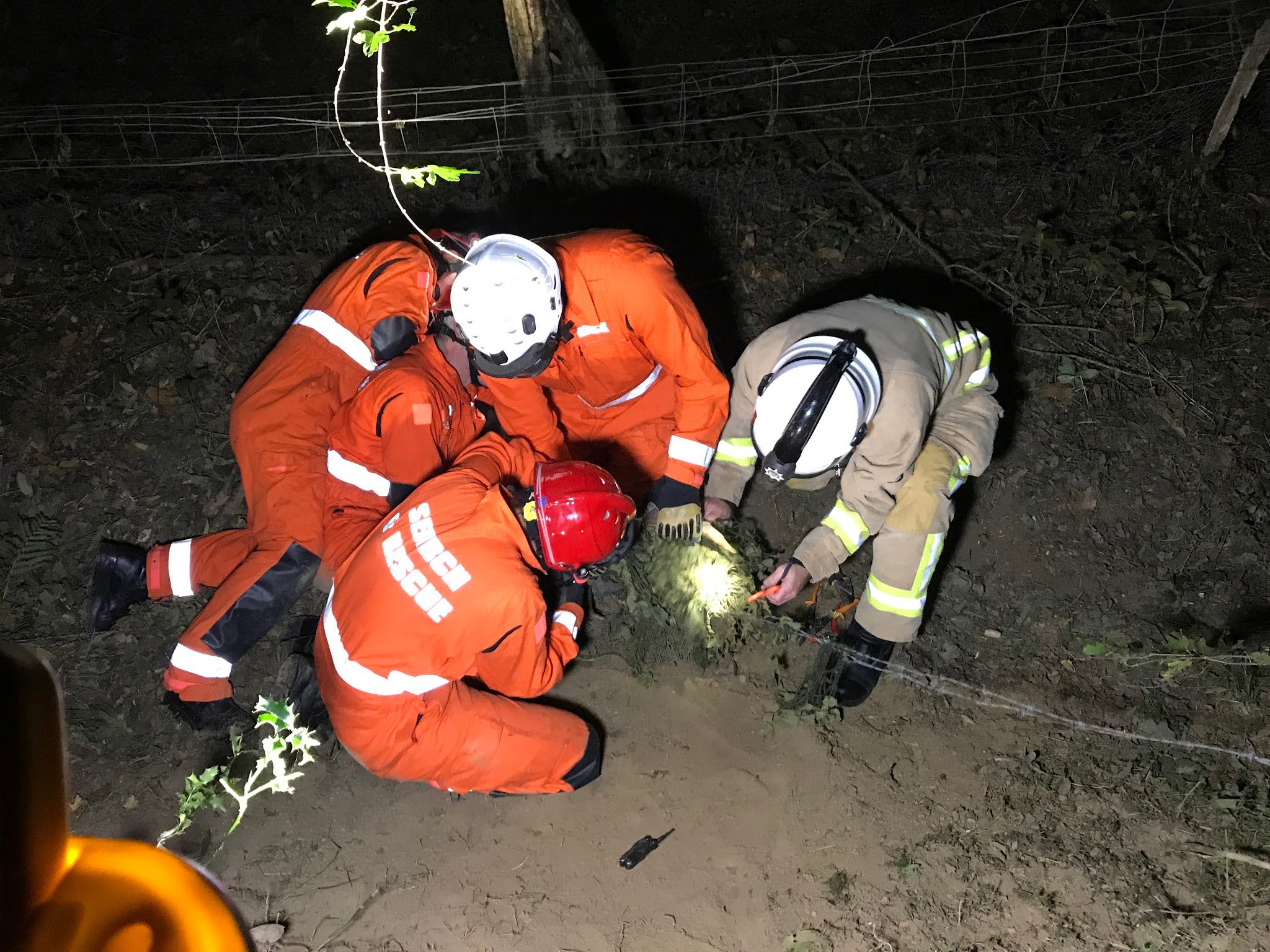
If bitten or scratched, clean area thoroughly as soon as possible. If bitten seek medical attention on the same day.
Transporting smaller animals to the vets
Information to give to the vets:
- Exact location where rescued from - especially important for birds of prey, foxes and badgers for releasing back in situ.
- How long the casualty has been trapped - if known.
- Behaviour of the animal - is it BAR, quiet, weak, collapsed.
- Is it injured or does it require immediate euthanase due to the extent of its injuries? - if so please let them know, as there is a risk of animals being left in a box/cage until checked by a vet if they are busy.
